
Set up your platform by running through the different features available. Create a theme with unique features individual to your company, create high-level users, create roles & access rights, add your assets (vehicle and driver information) and much more.
Table of content
1. Assets
1.1 Creating and Editing Assets
1.1.1 Creating Assets
To create Assets:
1. Go to Administration,
2. Choose the Assets section under the Client,
3. Click the Plus button,
4. Enter the information in the Wizard,
5. Click Next. Enter the information in the wizard, as requested, for Asset Categories and Custom Fields.
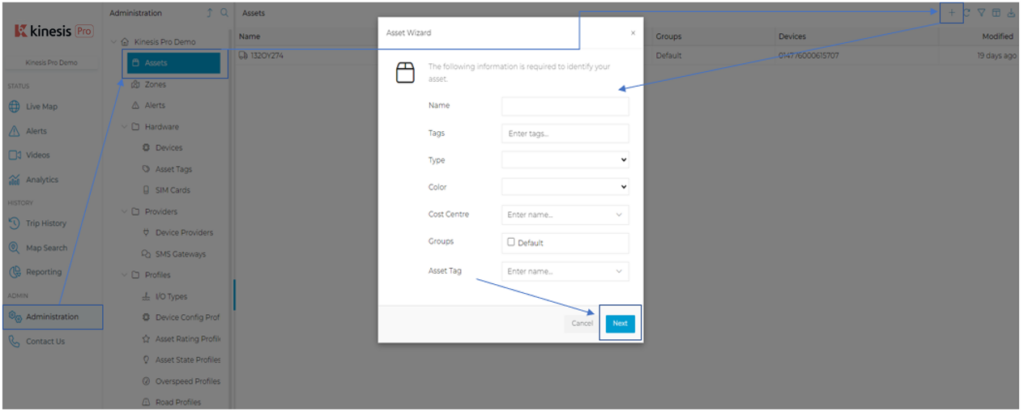
1.1.2 Editing the Assets from the Live Map Screen
With the correct permissions, you are able to edit Asset Names and Colour of an Asset on the Live Map page.
1.2 Asset Events
1.2.1 Introduction
Asset Events are a set of conditions per Asset that trigger events.
Events can be used to generate alerts. For example, if a vehicle speeds, or if the temperature reading goes too high, a fuel level has a sudden drop, or a driver over-revs the engine, those are events.
Alerts, use those events to sound the alarm, or notify someone of this issue.
These triggers/events can be edited on Assets, individually, or in bulk.
1.2.2 Find and Edit the Asset Event triggers
(1) INDIVIDUAL ASSETS
1. Go to Administration,
2. Choose the Assets section under the Client,
3. Choose the Asset you would like to edit from the list,
4. Choose the Events section on the Asset,
5. Click the Edit button on the section you would like to edit.
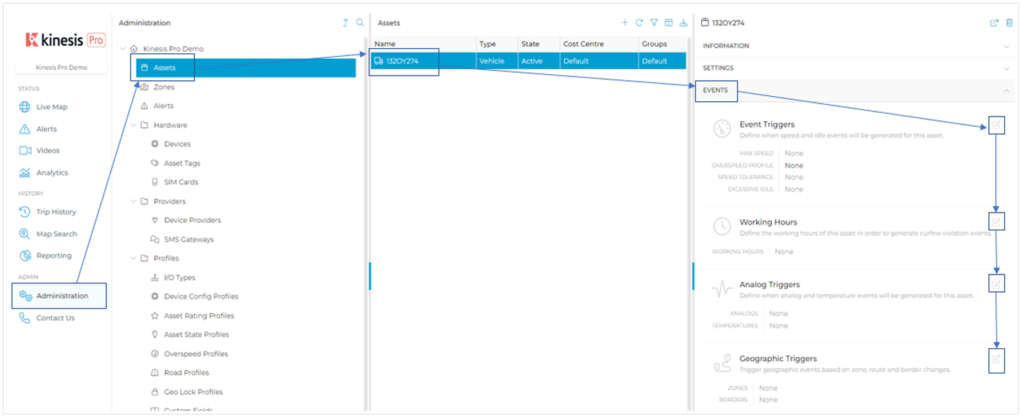
(2) MULTIPLE ASSETS (BULK)
1. Go to Administration,
2. Choose the Assets section under the Client,
3. Choose the Assets you would like to edit from the list (ctrl-click on more than one Asset),
4. Choose the Events section on the Assets,
5. Click the Edit button on the section you would like to edit.
Please note – any information already in the sections will disappear, and any changes made will affect all the Assets chosen.
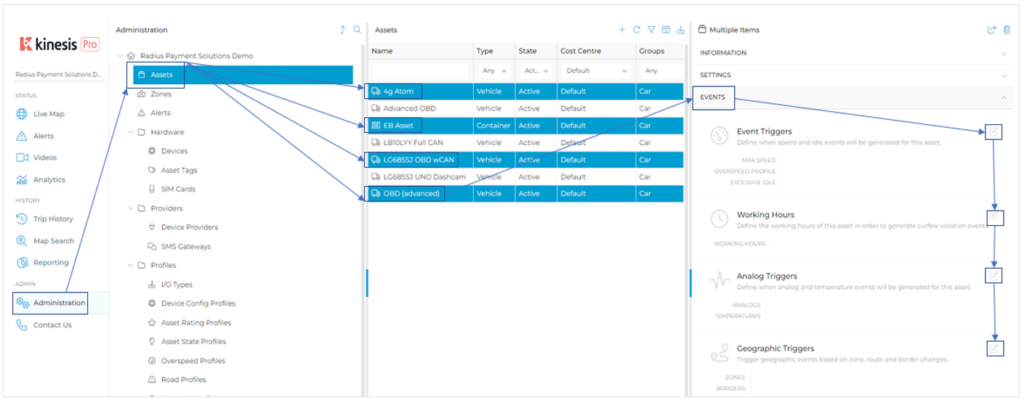
Add the Min and Max Range (if one of the limits is not needed, then add a number that will never trigger an event), the Range Debounce* (how many positions of data to use [generally use 1 unless you want to see the value for a few more positions]), and Drop and Increase amount, depending on the Input.
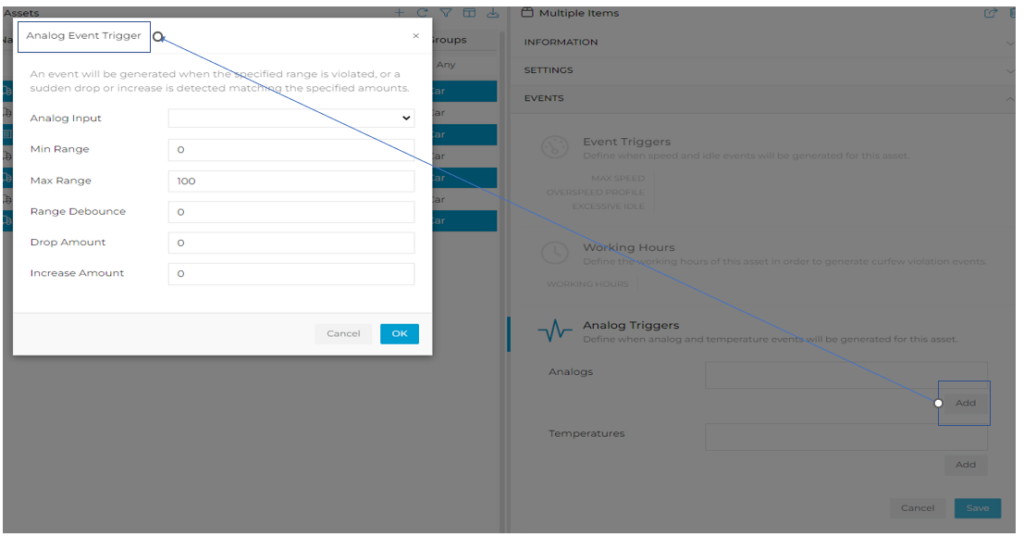
1.3 Events triggers
1.3.1 Geographic triggers
If you would like to trigger an event when an Asset crosses a specific Zone boundary, or State/Province or Country Border, set this up under Geographic Triggers:
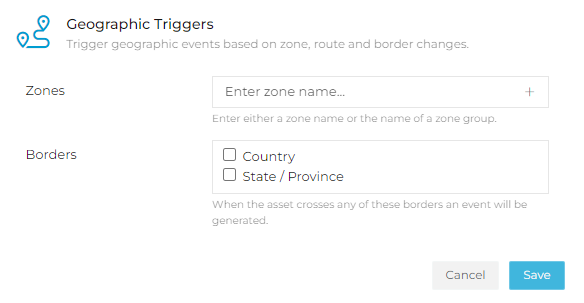
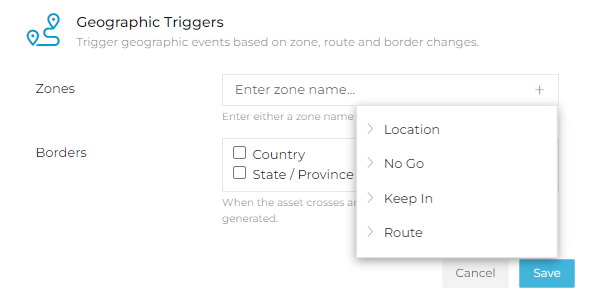
1.3.2 Speed and Idle
Speed
The platform uses the lower of map road speed limits, location speed limit, and Asset Event Triggers (Max Speed and Tolerance) to generate Speeding events. The platform will apply the lower limit, with the tolerance added on as the speed limit.
The platform does not know what type of vehicle you are tracking – it could be a Caterpillar Grader, a 10Ton Truck, or High Performance car. Each of those vehicles has different maximum speeds allowed on roads, and the map road speed limits may not apply. For example, a Caterpillar Grader may only be allowed to go a maximum of 30 with 0% tolerance and would be speeding if going any speed above 31, so 40 on a road with a 40-speed limit, 50 on a road with a 50-speed limit etc. Any speed limit above 30 is ignored. Set these values as required per Asset, either individually or in bulk.
In the example below, the following speeds would be considered speeding (11% above the map speed limit):
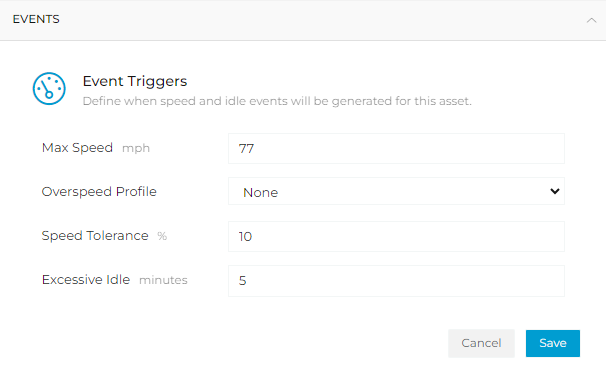
| Map or Location Speed Limit | Speeding Event |
| 40 | 45 |
| 60 | 67 |
| 80 | 89 |
| 100 | 111 |
| 120 | 133 |
In the example below, the following would be considered speeding:
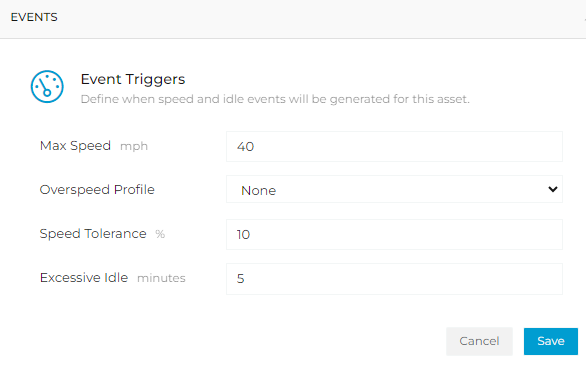
| Map or Location Speed Limit | Speeding Event |
| 30 | 34 |
| 40 | 45 |
| 50 | |
| 60 | |
| 70 |
Idling
The platform will generate an Excessive Idling event using the value set on the Asset/s. If the Asset idles for longer than the limit set, an event will trigger and be used to generate an Alert. Set this value according to the Asset being monitored.
1.3.3 Working hours
Working hours can be added to an Asset, which allows Users three outputs:
1. Curfew violations – an Alert can be generated when an Asset is utilised outside of working hours,
2. Curfew Violation Report – generates the trips taken outside of working hours, either in Listing or Daily Summary format, like the Trip Listing Reports, and
3. Asset Utilisation Report – these can be run using the working hours to determine the utilisation statistics within those hours. Items like distance, idling and active time can be generated within these hours.
After clicking the Edit button next to Working Hours,
1. Click Add under the Curfews section. A pop-up will appear with
2. Time of day the hours should start and end,
3. Time Zone, and
4. The Days of the week the hours need to apply to.
5. When the information is correct, click OK.
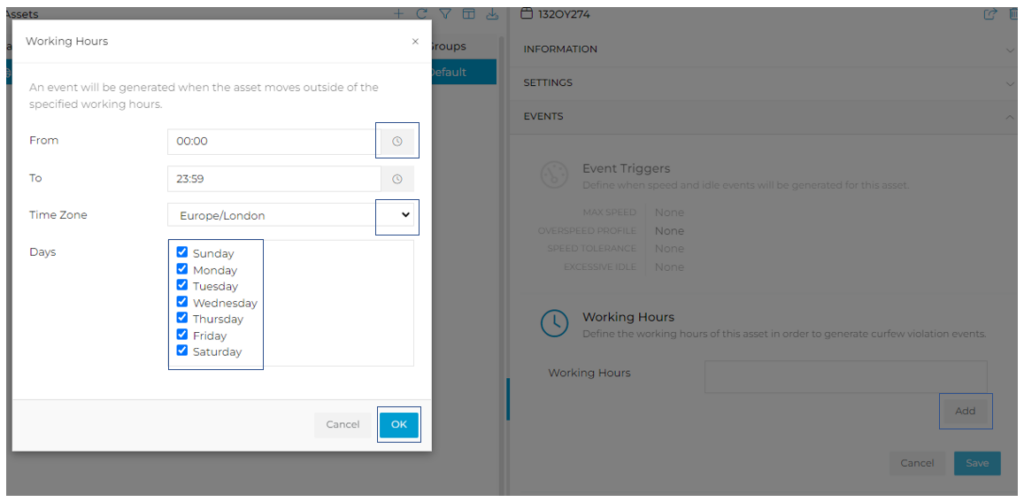
Add the hours per day, and repeat if there are more than one set of working hours. For example, if Assets can be used from 08h00 – 17h00 during the week and 09h00 – 13h00 on a Saturday, create two sets of working hours. One for the week and one for Saturday.
Please note: the “day” ends at 23:59. If an Asset works overnight, e.g. 18h00 to 06h00, please create one set of working hours from 18h00 – 23h59, and a second set from 00h00 – 06h00.
1.3.4 Analog Triggers
Analog triggers include all Analog, CAN and Temperature values coming from the Device. The data from the Device can be used to Trigger the following events:
1. Low-range event – i.e. when the data value drops below this level,
2. High-range event – i.e. when the data value rises above this level,
3. Drop event – i.e. when the data value drops quickly,
4. Increase event – i.e. when the data value increases quickly.
Examples of the above include things like
- RPM – when the value goes too high = over-revving
- Temperature – when the value goes too high or too low = out of acceptable range for the goods in transit,
- Fuel level – when the value drops quickly = fuel theft
- Fuel level – when the value rises quickly = fuel fill up
In the examples below, we would like to know when a vehicle is being revved excessively and when the battery of the vehicle is potentially draining. The two blue lines in the middle represent the ranges, and the arrows represent the drop and increase.

1.3.5 Creating Alerts from Event Triggers
To create an Alert from Event Triggers, please set up the rest of the Alert as per normal, and choose the type of Range or change event from the following options:
1. Select action…
2. Analog/CAN Violations = Analog and/or CAN triggers,
3. Border Crossing = Geographic triggers,
4. Excessive Idle = Idling limit trigger
5. Overspeed = Speeding triggers,
6. Temperature Violation = Analog trigger for temperature.
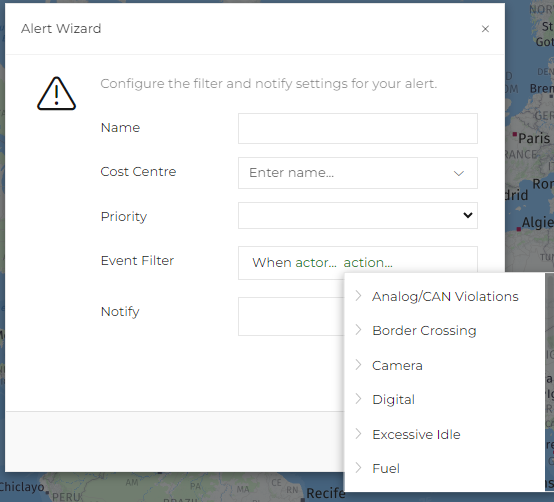
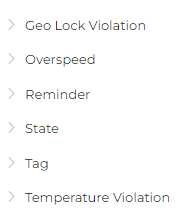
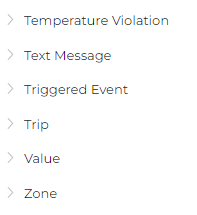
Curfew Violation alerts, generated from the use of an Asset outside of Working Hours, are found under the Triggered Event section:

1.4 Asset settings
1.4.1 Introduction
Asset Settings are a set of items that are used to manage Assets. Things like the addition of Asset Rating Profiles, Asset States, Asset Reminders and the ability to Share are managed under Settings. Users can also update Odometer and Engine Hours values, which can be used in Asset Reminders as well.
1.4.2 Profiles – Asset Rating and State
To trigger a rating or state profile, these have to be assigned to the correct Asset/s.
RATING
Create the Rating Profile, then add it to an Asset, or group of Assets
STATE
Create an Asset State, then add it to an Asset, or group of Assets
1.4.3 Odometer and Engine Hours
The real odometer and engine hours of the vehicle can be added to the Asset in the platform. This allows for accurate reporting and setting of odometer-based reminders (see below).
A few important points about the odometer values
A value cannot be entered into the Odometer field unless the Device has reported a valid GPS position, and the odometer value coming from the Device is greater than 1.
If the Device is configured to send it’s Odometer value to the platform, this will be captured in the Telemetry, and the column will be labelled odometer (this will always be in Kilometres). The Odometer field of the Asset will automatically update. This can be left as is, or to reflect the Odometer value of the Asset and not the Device, change the Odometer value accordingly.
If the Device is not configured to send the Device Odometer value, the software will create an odometer reading for the Asset, and will be seen in the Telemetry as the odo_counter column. This does not automatically populate the Odometer field of the Asset, and the Asset value needs to be added.
When setting an odometer and Engine Hours value, the value, as well as the date, can be adjusted. The screenshot below shows the Odometer field, which contains the same elements as the Engine Hours field.
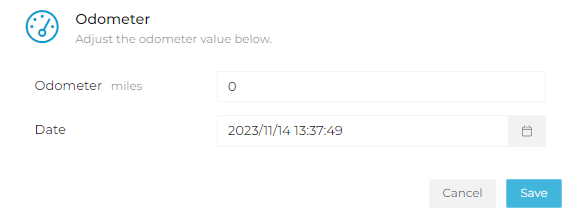
An important point about the engine hours values
Engine hours are never populated automatically on any asset. The value needs to be entered for it to accumulate.
NOTE: if a different date is chosen (in the past) to the current day, the data between then and now must be accurate for the platform to work out the current Odometer/Engine Hours value. The platform will add all the recent trips to the value entered to reflect today’s value for the Odometer and Engine Hours.
1.4.4 Reminders
The platform supports various types of asset-based reminders. These include odometer, hours and time-based reminders, which be set once-off or as recurring reminders. Any reminder created generates an event which can be used to trigger an alert.
Choose the type of Reminder and frequency from the options available.
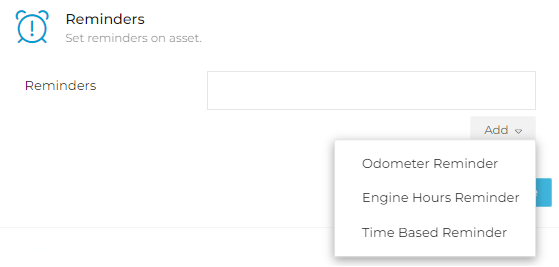
Every time the Reminder triggers, an event is generated, which can be used to generate an Alert.
Odometer reminder
An Odometer Reminder will trigger when the specified Odometer value is reached. This can be set once off, or repeated every x distance, and reset after each reminder, or daily, weekly or monthly.
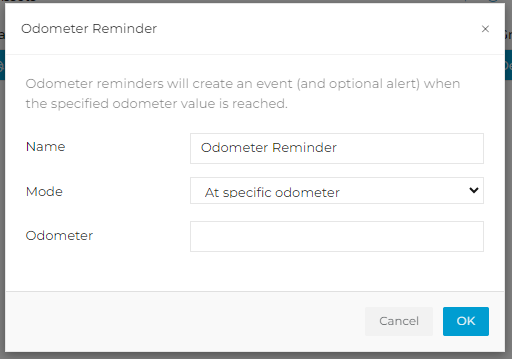
Engine hours reminder
An Engine Hours reminder will trigger when the specified Hours are reached. This can be set once off, or repeated every x hours, and reset after each reminder, or daily, weekly or monthly.
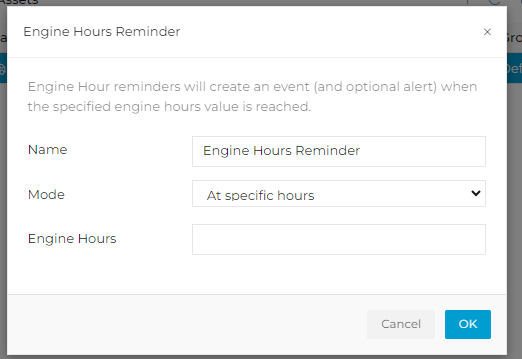
Time-based reminder
A Time-Based reminder will trigger when the specified Time is reached. This can be set once off or repeated every x days.
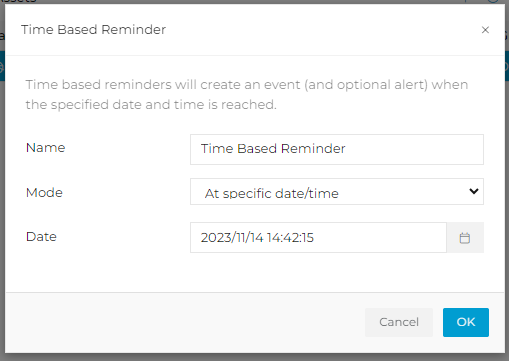
2. Zones
2.1 Introduction
Geofence zones define a specific geographic location on the map.
When Assets enter or exit Zones, Events are created that can be used to trigger Alerts.
A zone can have a proximity warning, which is a circular area around the zone. Events are also created for an Asset entering and exiting the proximity of a zone, which can also be used to create Alerts.
Zones can also be used to set speed limits for certain geographic areas.
There are three types of zones in the platform, as described below:
| Zone type | Colour | Overview |
| Location | Blue | The name of the Location appears in the telemetry and overwrites the address where the Asset is. |
| No Go | Red | The normal street address appears in the telemetry. |
| Keep in | Green | The normal street address appears in the telemetry. |
Users are able to view the Zones in a Client, whether in Zone Groups or not and create new Zones from the Administration section.
2.2 Create a Zone
1. Navigate to Administration,
2. Choose Zones
3. Click the Plus button,
4. Enter the information in the Wizard, including whether a speed limit and proximity warning are needed,
5. Then click Next.

6. Enter the GPS coordinates in decimals,
7. Choose a Shape from the drop-down list,
8. Specify the Radius of the Zone,
9. Click Next.
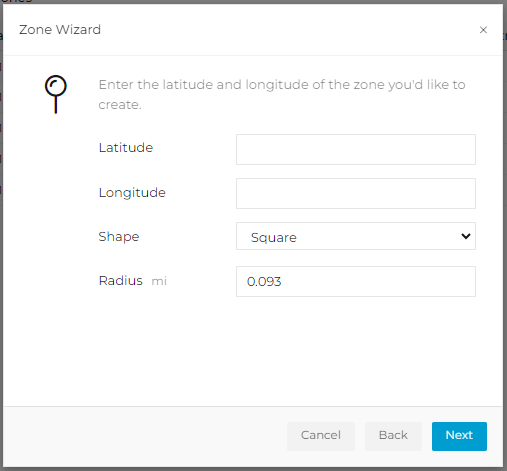
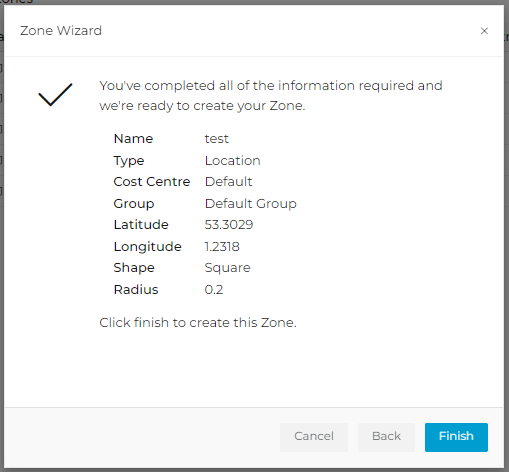
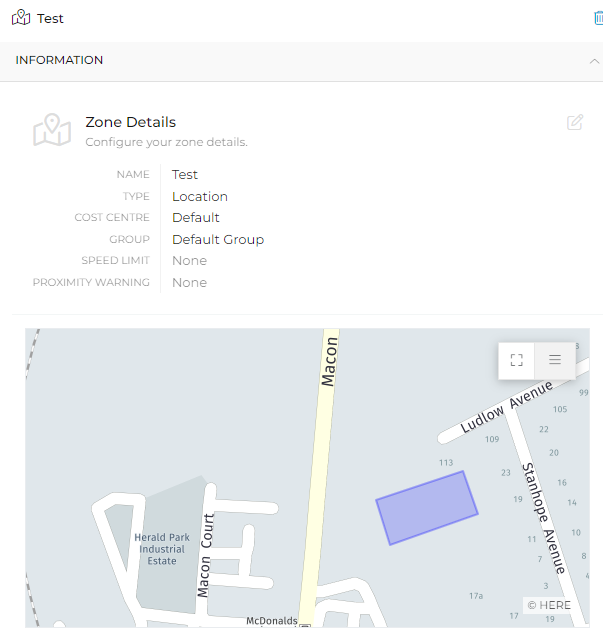
2.3 Edit a Zone
The Zone Information
Choose the Zone from the list and choose the Edit option under the Zone Details.
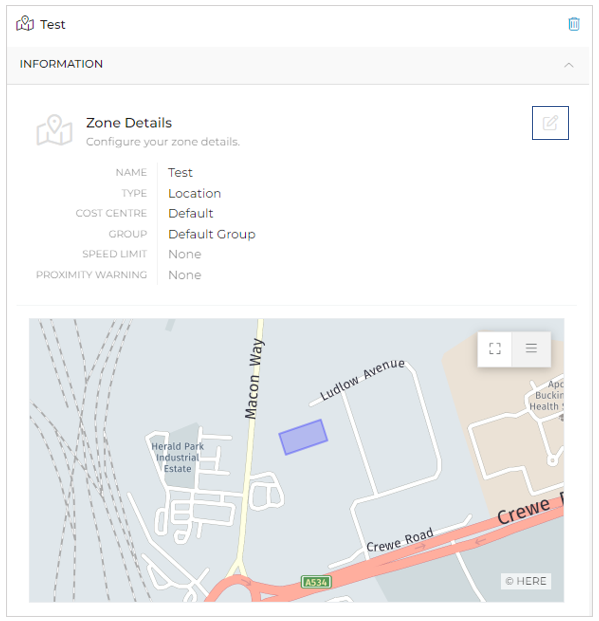
3. Alerts
3.1 Introduction
Kinesis Pro allows users to receive alerts in real-time, by email. Alerts are triggered by events which come from:
1. The Device directly – e.g. impact, harsh braking,
2. The software set-up, in combination with the Device’s data – e.g. speeding, fuel fill-ups, temperature violations.
3.2 Create an Alert
1. Go to Administration,
2. Choose the Alerts section under the Client,
3. Click the Plus button,
4. Enter the relevant information in the Wizard (explained below).
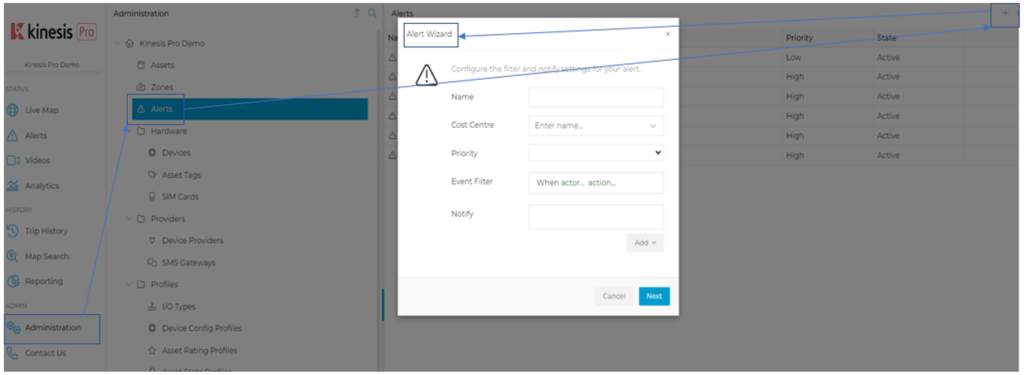
The actor corresponds to which Asset will trigger the Alert (WHO). Specific Assets can be added by typing in their name or groups chosen under the Asset types.
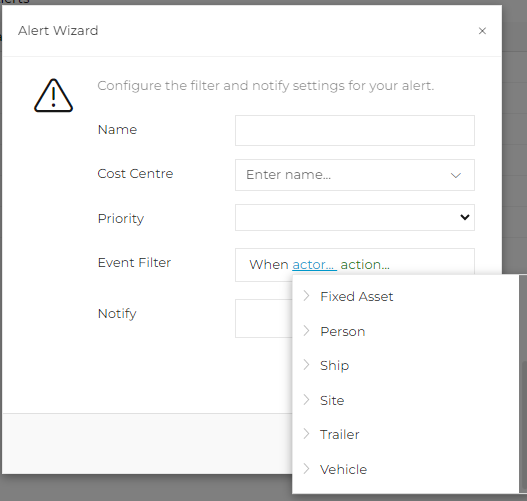
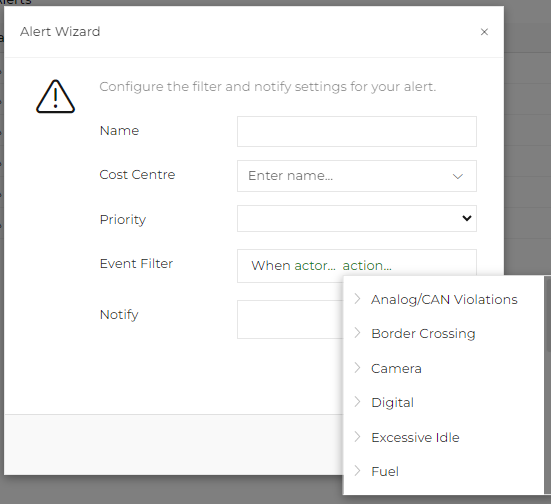
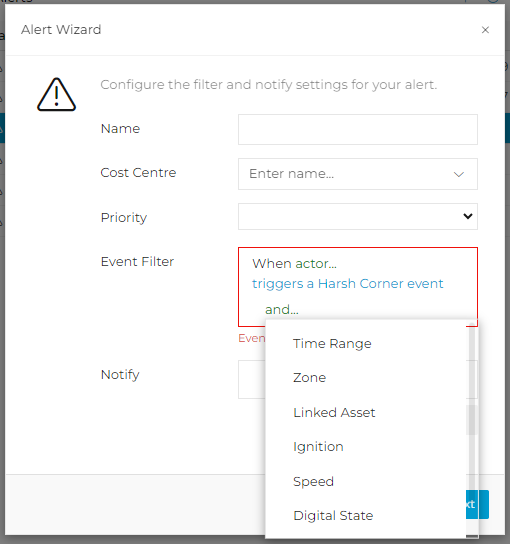
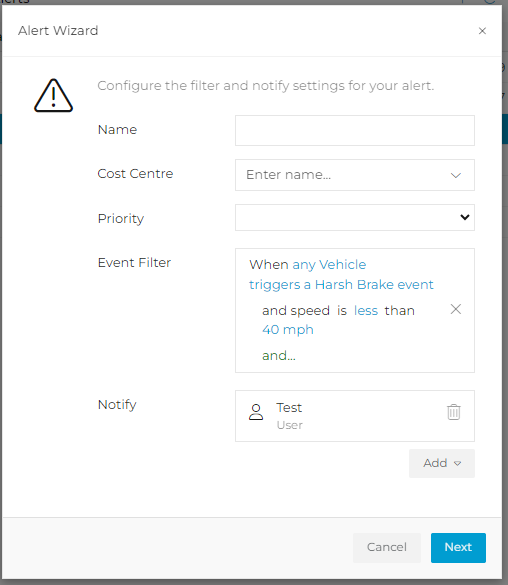
4. Profiles
4.1 Asset Rating Profile
4.1.1 Introduction
Asset Rating Profiles are used to rate the performance of an Asset (e.g. vehicles, drivers etc) for each trip it completes.
A Rating profile is created from events, and by specifying penalties for those events. When the events chosen trigger during a trip, the penalty is deducted from the score of the Asset for that trip. The perfect rating score is 100.
Kinesis Pro allows Users to create their own Rating Profiles, which can be built based on the Assets in the Client. A Client can have more than one Rating Profile, however, an Asset can only have one assigned to it.
4.1.2 Creating a Rating Profile
Create a Profile Name
1. Go to Administration,
2. Choose the Assets Rating option under the Profiles section,
3. Click the + button above the Rating Profile list,
4. Add a Name for your profile,
5. Click the Next button, and you will be asked to confirm the name and Finish that part of the set-up.
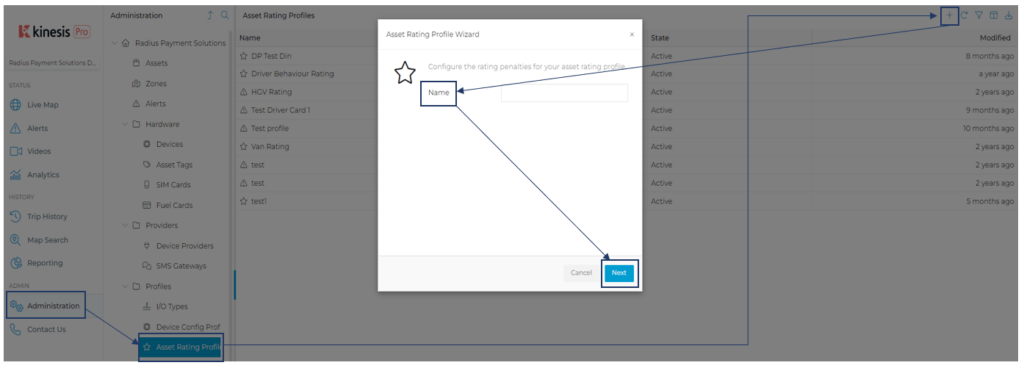
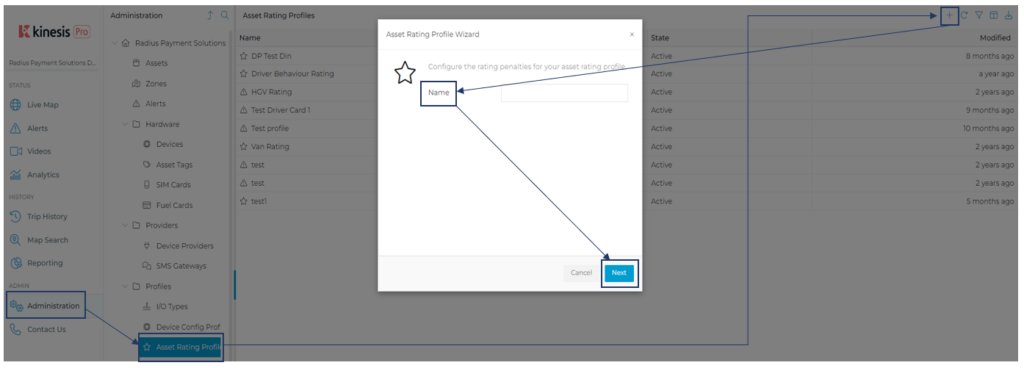
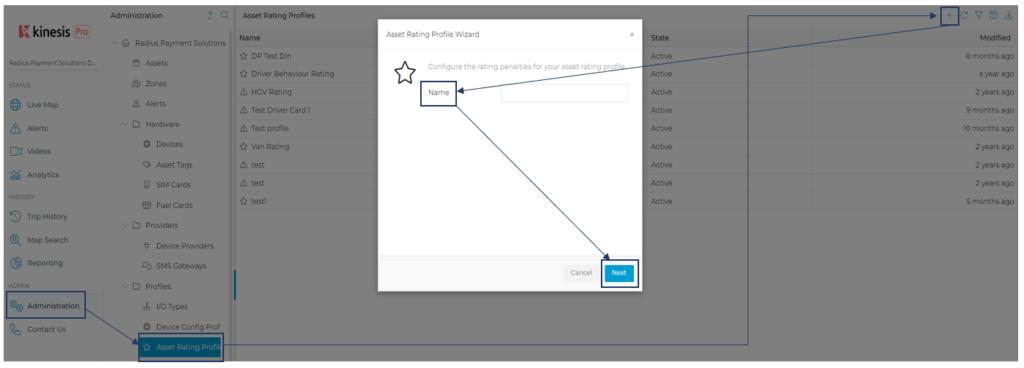

In this example of a State, the vehicle activates a Harsh Braking event, and the vehicle is inside a certain zone/group of zones:
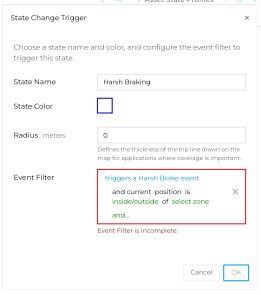
Adding an Asset State Profile to an Asset or Multiple Assets
Individual Assets
Choose the Asset you would like to add the State Profile to, open the Settings section, and add the Profile.

Multiple Assets
Choose the Assets (ctrl-click) you would like to add the State Profile to, open the Settings section, and add the Profile.

4.2 Overspeed Profile
4.2.1 Introduction
The platform offers two ways in which to measure overspeeding on assets:
Instantaneously
- An Overspeed is recorded when an Asset goes over the speed limit of the road or location.
- The Overspeed event is defined by the road speed limit and any tolerance set on the system against the Asset.
- This is an Overspeed event and triggers on the first data point breaching the threshold, and every time a subsequent infringement occurs. (START of the speeding)
Retrospectively
An Overspeed event is recorded by measuring the distance and time of an infringement.
This is by using the Overspeed Profile, usually bands ( 0-10%, 10-20% & 20%+), based on the severity of the speeding.
This measures how long the Asset was in each band, i.e. how long did the person stay in each band during a trip/day etc. (BANDS)
The Overspeed Profile is designed to measure the time and distance of speeding, to help differentiate serial speedsters from a driver occasionally overtaking another vehicle, and infringing the speed limits once off. The difference between an overtaking manoeuvre, and constant speeding are highlighted in these snippets from a speed graph:

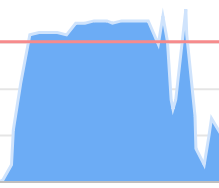
The Over speeding Profile can be split into bands, which are User defined. For ease of understanding, all the examples described in this article will use a reference of Low, Medium and High bands. Bands can be called anything, with a % value above the speed limit for each. In this table below, two different examples are shown for a 3 tiered Low/Medium/High profile:
| Band | Example 1 | Example 2 |
| Low | 0-5% | 5-15% |
| Medium | 5-10% | 15-25% |
| High | >10% | >25% |
Each time the Asset moves into the band, the platform will start recording the time and distance. Only once the Asset moves into another band, or below the lowest, will this be recorded and displayed as an event. The event occurs at the end of the speeding, and should not be used to trigger an alert (i.e. it is too late to do anything with the Alert, as the speeding is finished).
The event will look like this:

The speeding event was 60 seconds and 2.16km long. It was in the Low band.
Speeding bands can also be used in the Asset Rating Profile, with the time or distance used as a penalty, i.e. if a driver goes into the High band, and stays there for > 10 seconds, they can be penalised accordingly. Please see below for a detailed description of how to set this up. There are three steps to using Over speeding bands in a Rating Profile:
1. Create an Overspeed Profile,
2. Add the Overspeed Profile to the Asset/s required,
3. Create or edit the Asset Rating as needed.
4.2.2 Create an Overspeed Profile
Over speeding profiles can be created. Once created, they need to be assigned to the Asset/s to trigger the events.
To create a new Overspeed Profile follow the steps below (example is within a Client):
1. Go to Administration,
2. Choose the Overspeed section under the Profiles folder,
3. Click the Plus button,
4. Enter the information in the Wizard,
5. Click Next, enter the information required on the next screens, until you reach the Finish button.
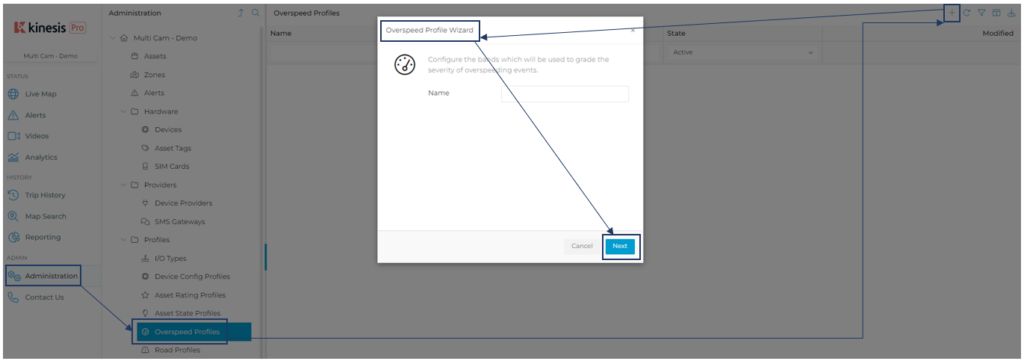
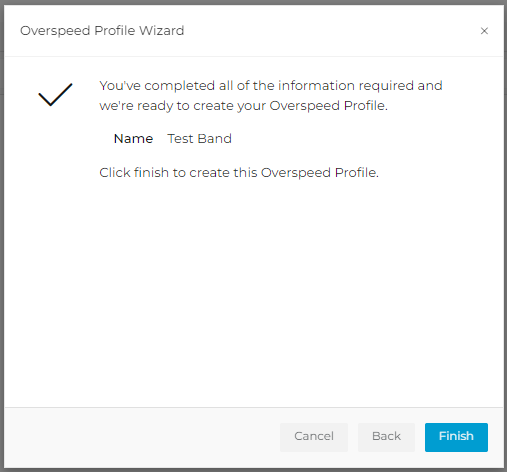

1. Adding Bands to the Profile
Edit the Overspeed Profile, then
1. Click Add,
2. Complete the details in the Overspeed Band box,
3. Click OK, then Save those changes.

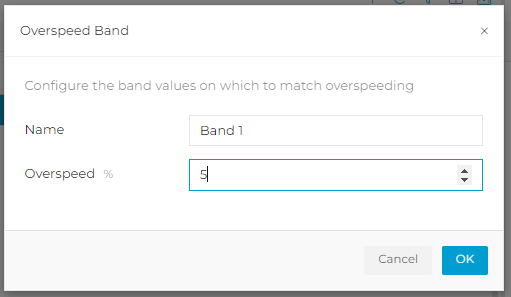
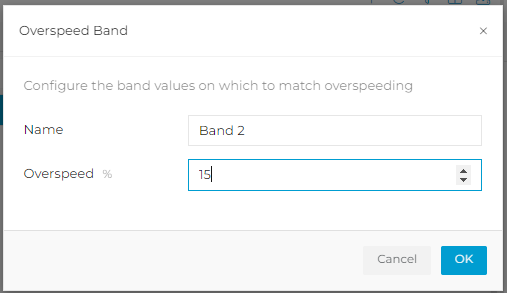
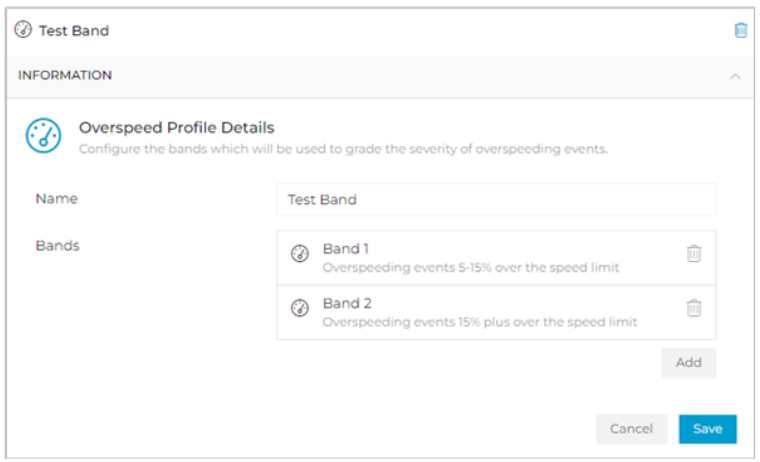
2. Adding an Overspeed Profile to an Asset or Multiple Assets
Individual Assets
Choose the Asset you would like to add the Overspeed Profile to, open the Events section, and add the Profile.

Multiple Assets
Choose the Assets (ctrl-click) you would like to add the Overspeed Profile to, open the Events section, and add the Profile.

3. Create or Edit an Asset Rating
Create an Asset Rating profile as per usual. To add a Band as an Event, follow the steps below:
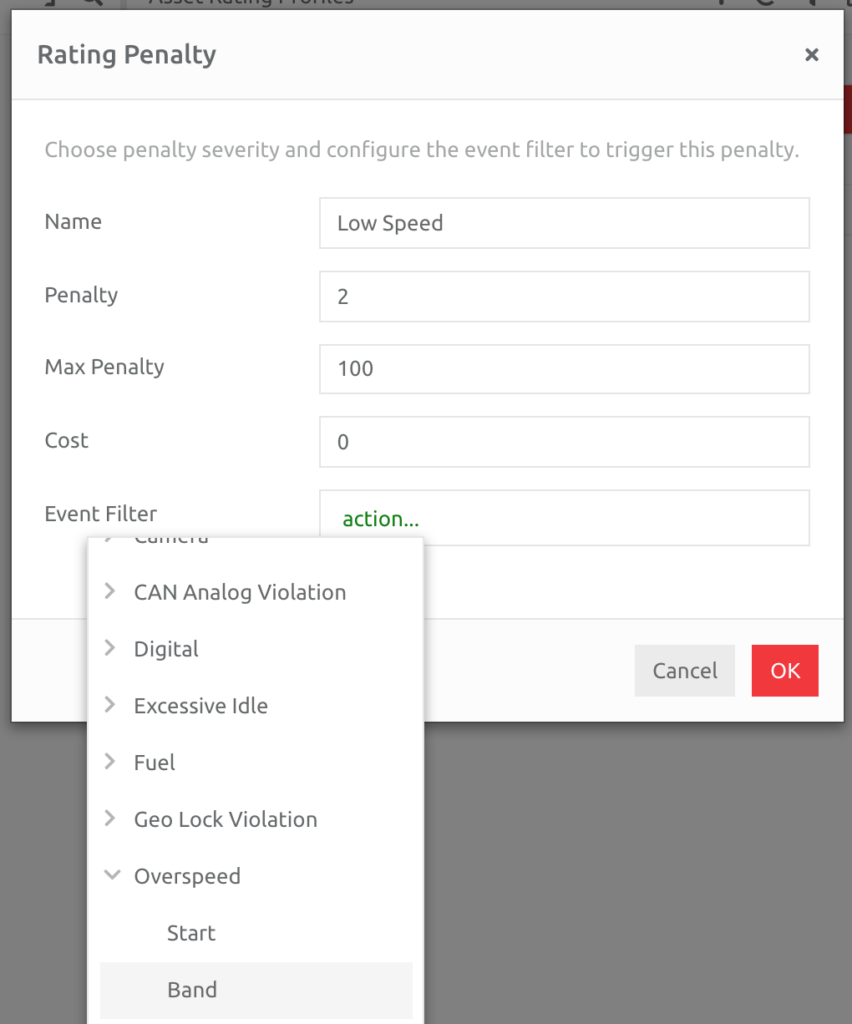
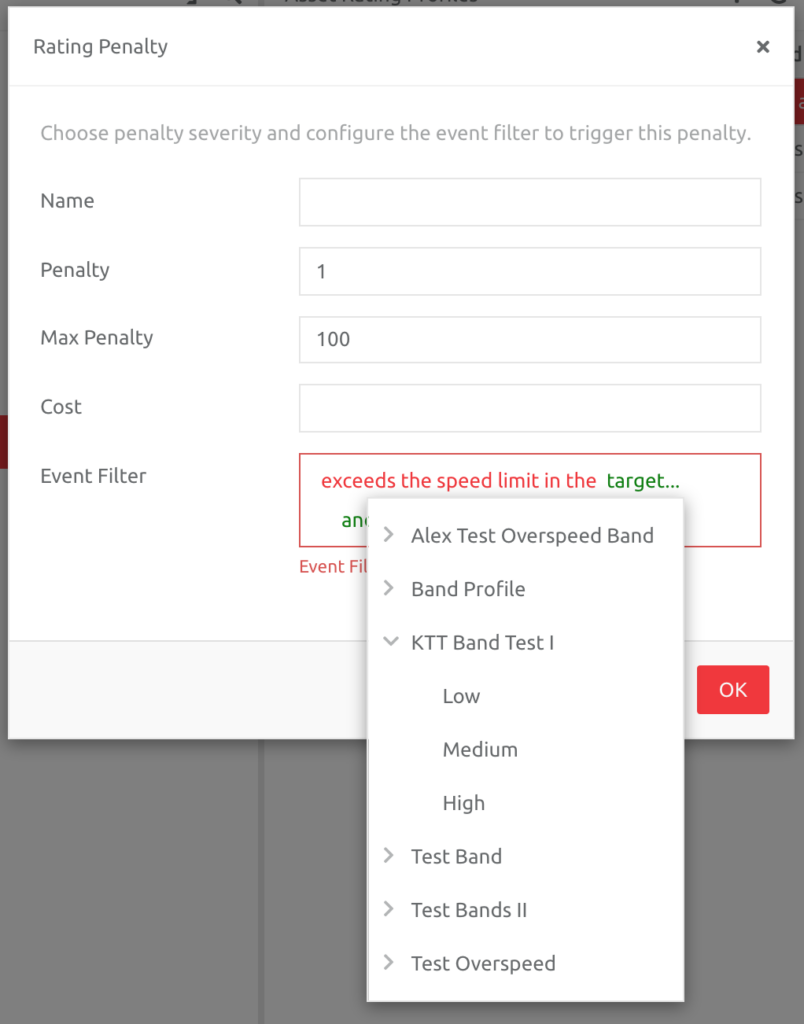
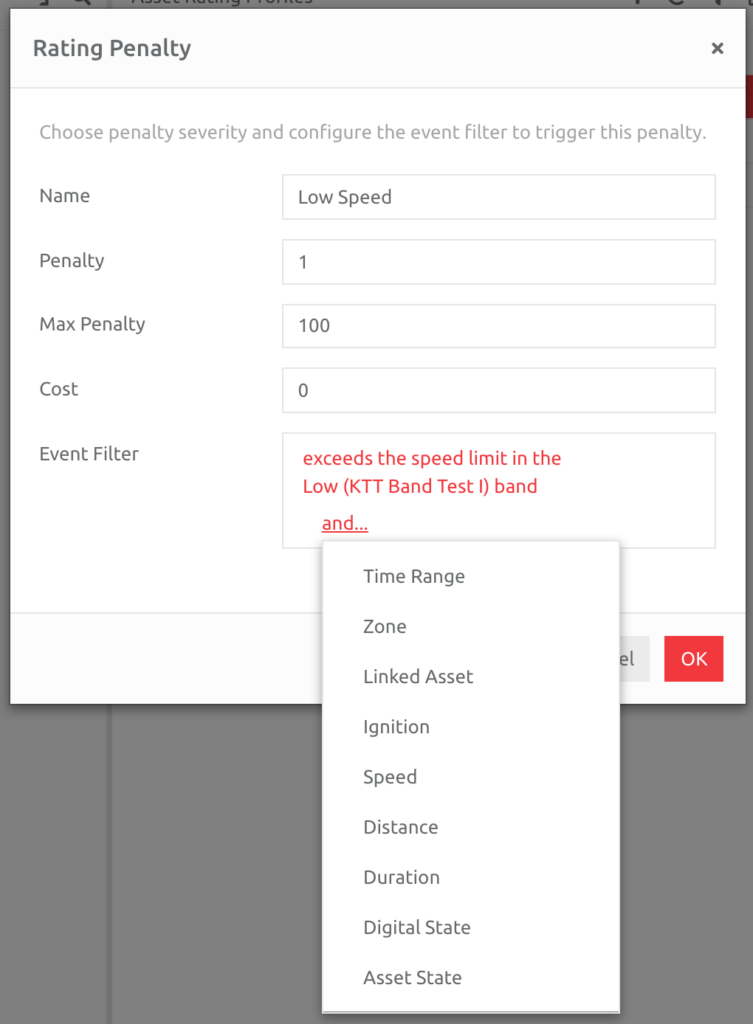
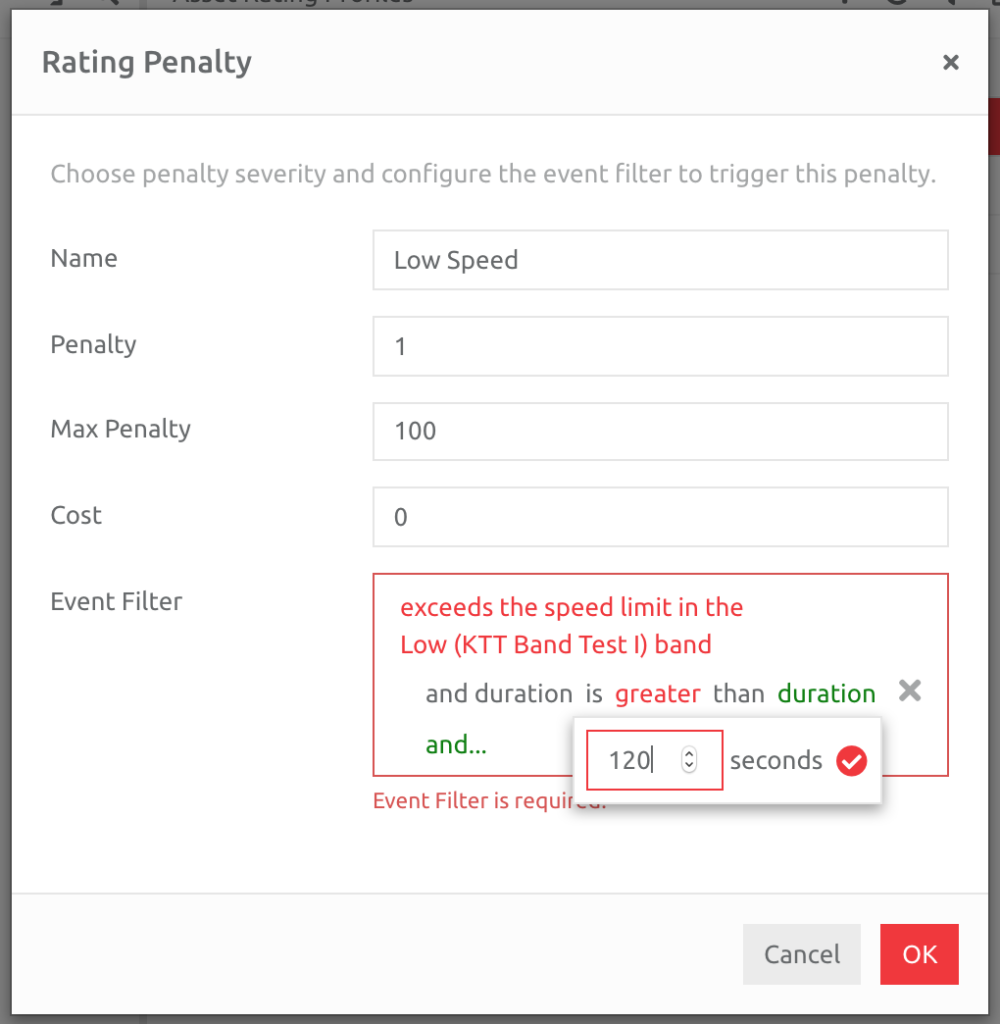
Reporting on Over speeding Events
Over speeding Events per Band Profile can be reported in two ways:
1. Standard Reports
- Over speeding Report – Profile shows Distance, Duration in each band, Maximum Speed, and Maximum Percentage over the speed limit.
2. Analytic Dashboards
- The Overspeed Profile Analytics Report includes the Instances and Distance and Duration for each band in the Profile.
- The Trip Analytics Report, if all or some of the profile has been used in the Asset Rating profile.
4.3 Road Profile
4.3.1 Introduction
Speed limits coming from the maps in the platform can be overridden by setting up Road Profiles. This allows users the chance to set their own speed limits, where regulated by the government or where the map speed limit is incorrect.
Speeding events are then measured against this new limit and not the road speed limit in the maps.
The feature is used to change the speed limit of the road based on:
1. The Speed Limit of a road,
2. Route Number starts with or contains (including alphabetic routes, e.g. R, A, N, M),
3. The actual Road Name,
4. The type of Carriageway (single or dual),
5. Geographic Boundaries (e.g. suburb, town, country), and
6. Time Range.
The same items above can be used as rules in the filter.
For example, you can set up a filter that includes the Road Name, and the Time Range, and a Town. The filter can be general or very specific.
Used in conjunction with Max Speed value on an Asset, speed limits can be carefully and comprehensively managed.
4.3.2 Creating a Road Profile
1. Go to Administration,
2. Choose the Road Profiles option under the Profiles section
3. Click the + button above the Road Profile list,
4. Add a Name for your profile,
5. Click the Next button, and you will be asked to confirm the name and Finish that part of the set-up.
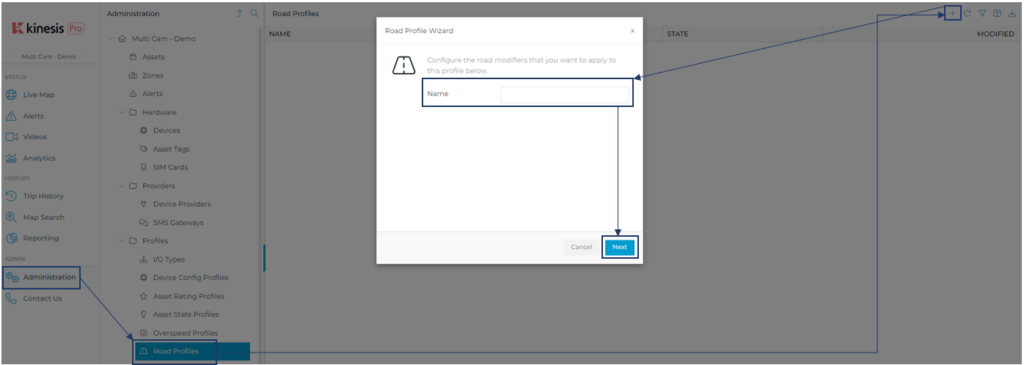
Adding Events and Penalties to the Profile
Edit the Road Profile, then
1. Click Add,
2. Complete the details in the Road Speed Modifier box,
3. Click OK, then Save those changes.
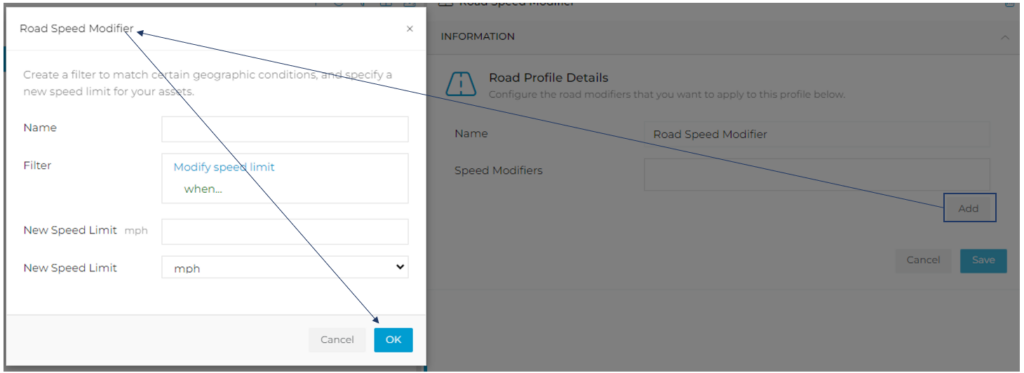
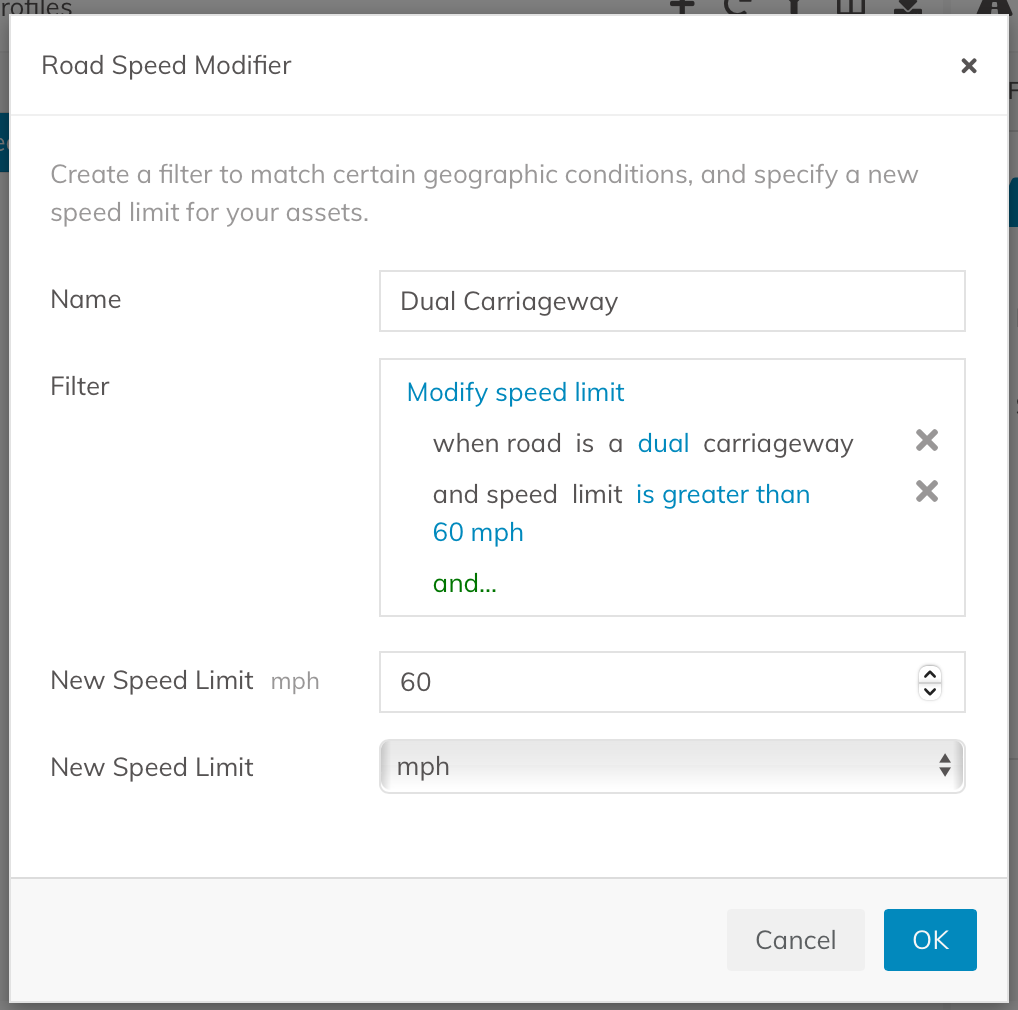
abc
In the following example of a Modifier, the speed limit is limited to 60mph on a dual carriageway where the speed limit is greater than 60mph.
Adding a Road Profile to an Asset or Multiple Assets
Individual Assets
Choose the Asset you would like to add the Road Profile to, open the Settings section, and add the Profile.

Multiple Assets
Choose the Assets (ctrl-click) you would like to add the Road Profile to, open the Settings section, and add the Profile.

Please note – any Road Profile already added to any of the Assets will be over-written.
Viewing Road Profiles Filters
The custom speed limit (based on the filters) is displayed on the speed graph on Trips when applied:

4.4 Geo-Lock Profiles
4.4.1 Introduction
Geo-Lock Profiles are used to automatically geo-lock Assets, based on a set of rules defined by the User.
Different Asset types based on groups, cost centres etc, can be geo-locked at different times on different days, using multiple Geo-Lock Profiles.
Multiple rules can be added within one Geo-Lock Profile, allowing Assets to be locked at different times on different days or not locked at all on some days.
4.4.2 Creating a Geo-Lock Profile
Create a Profile Name
1. Go to Administration,
2. Choose the Geo Lock Profiles option under the Profiles section,
3. Click the + button above the Geo Lock Profile list,
4. Add a Name and Radius for the Geo Lock profile,
5. Click the Next button, and you will be asked to confirm the name, and Finish that part of the set up.
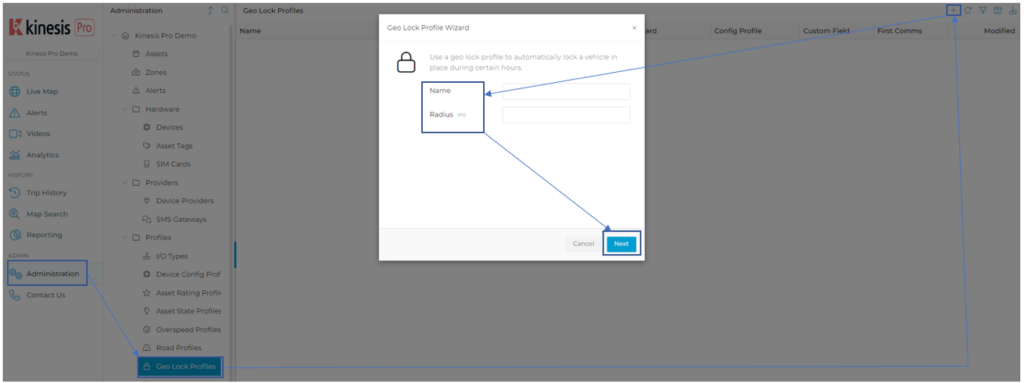
The Profile created will display a warning that it is not complete, and that penalties need to be added:

Adding Days and Times to the Profile
Edit the Rating Profile, then
1. Click Add,
2. Complete the details in the Geo Lock Times box, setting the From and To times,
3. Click OK.
If you would like to have multiple day and time triggers (e.g. weekend times differ to weekday times), then repeat the above procedure and add multiple day and time triggers, then Save those changes.
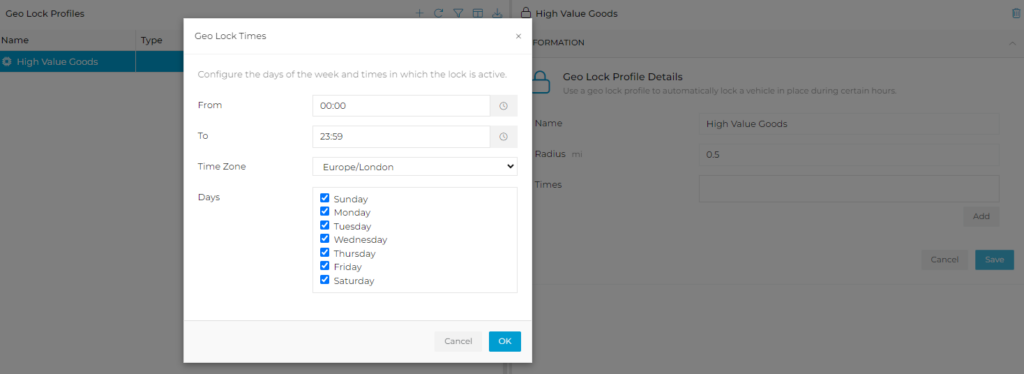
Adding a Geo-Lock Profile to an Asset or Multiple Assets
Choose the Asset/s you would like to add the Geo-Lock Profile to, open the Settings section, and add the Profile.

Viewing Geo-Locked Assets on the Live Map Screen
When the Geo-Lock time triggers, the Asset will be geo-locked automatically in the current position, indicated by a “lock” over the Asset:


From <https://support.keytelematics.com/support/solutions/articles/43000673732-geo-lock-profiles>
4.5 Custom Fields
4.5.1 Introduction
When creating items on the platform, there may be a need to include information that is pertinent but that is not part of the basic information on the platform.
This information can be added to items using the Custom Fields feature and displayed on the Asset Live Map screen, as well as reported on or used to filter items (e.g. Devices, Assets, SIM Cards).
For example, you may want to keep track of the Installation date or when a Driver’s license expires. You can also use Custom Fields to display the VIN of the vehicle. The information will be displayed in the item folder as a new column heading. In the screenshot below, the Installation Date of the Device has been included on some Devices:
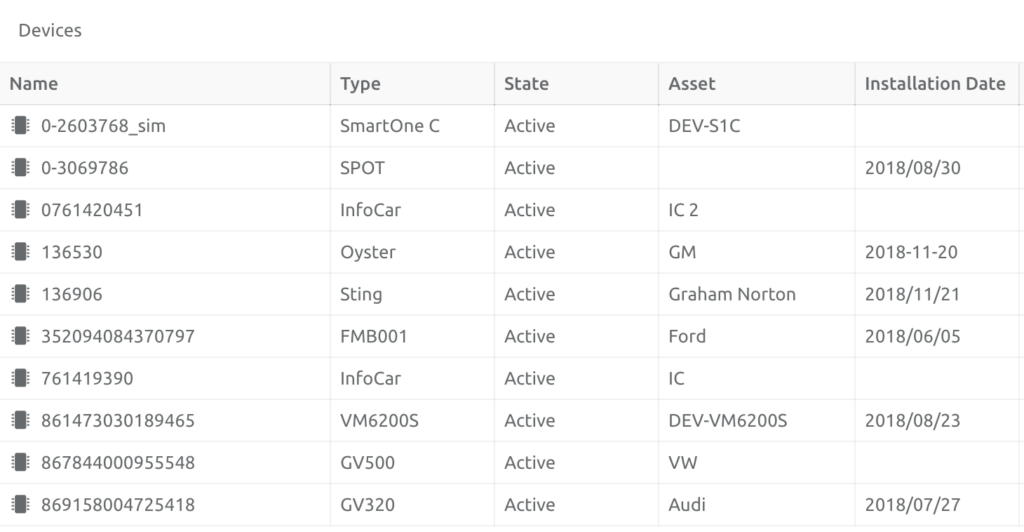
4.5.2 Creating Custom Fields
You can create Custom Fields
Before creating the Fields, choose the appropriate level. They are created under the Vendor or Client Profiles. The example described below is at a Vendor level.
1. Go to Administration,
2. Choose the Custom Fields option under the Profiles section,
3. Click the + button above the Custom Field list,
4. Enter the information* in the fields shown,
5. Click the Next button, and you will be asked to confirm the information, and click Finish to complete the set up.
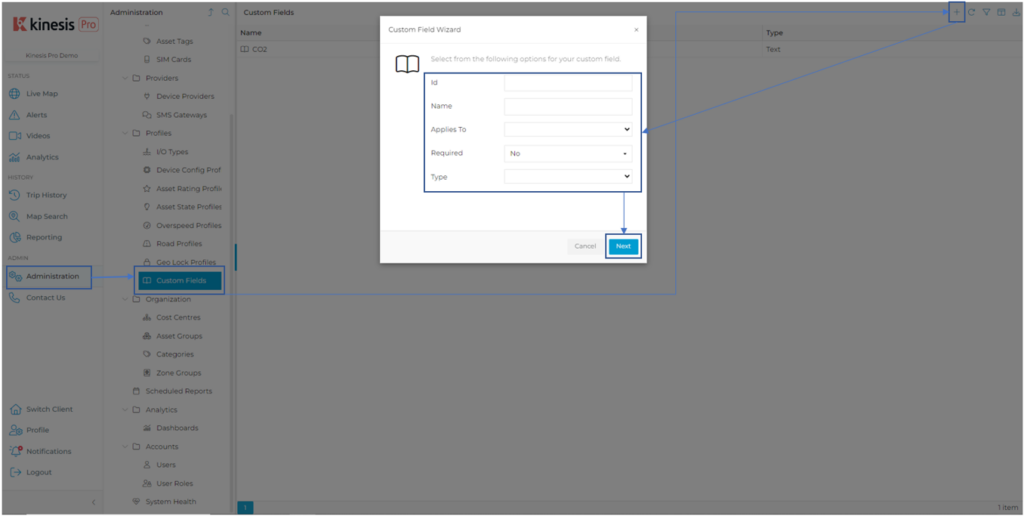
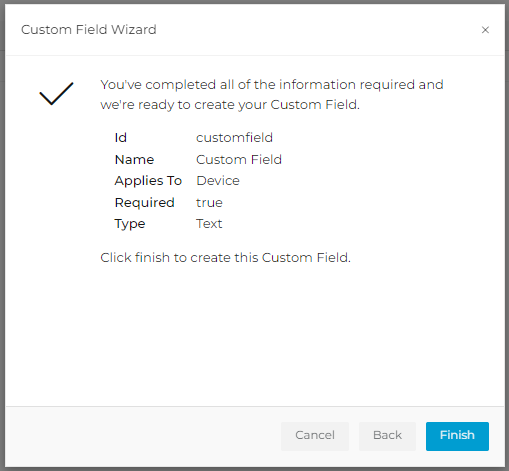
| ID | This is the ID that the platform uses to identify this type of information. It isn’t visible to users, but is important to the platform. You can enter any value here, but the platform will remove all spaces and any character other than ‘a’ to ‘z’ and ‘0’ to ‘9’. We suggest you enter the same value as you do for the Title. If 2 custom fields have the same ID, they will overwrite each other. Therefore it is important that this is a unique value. |
| Name | This is what will be used as the name whenever this information is displayed. |
| Applies to | This is a list of items that information can be added to. |
| Required | Select Yes here if you’d like to prevent the user from saving the custom fields information block if the value hasn’t yet been entered. Selecting No will allow the user to leave the field blank. |
| Type | This is the type of information that the user will enter. You have the following options: Text: a simple text box to add text information Memo: a multi line text box for entering multiple lines of text information Dropdown Box: a dropdown box that restricts Users to predefined values (see Values** row below) Date: a date selection box Date & Time: a date and time selection box Yes / No: a dropdown that restricts Users to Yes or No |
| Values** | You will only see the Values box if you’ve selected “Dropdown Box” from the Type field. Here you can enter the values that the user is allowed to select from. |
Adding Custom Information to an Item
After you have created Custom Fields, they will appear as a list on all items of that type chosen under Applies To, under the Information section.
These Fields can be edited and changed by choosing the Edit option in Information. Save when the Information has been completed:



Displaying/Using Custom Field Information
Asset Liveview Screen
Custom Fields are displayed on the right-hand side of the screen when an Asset is chosen:
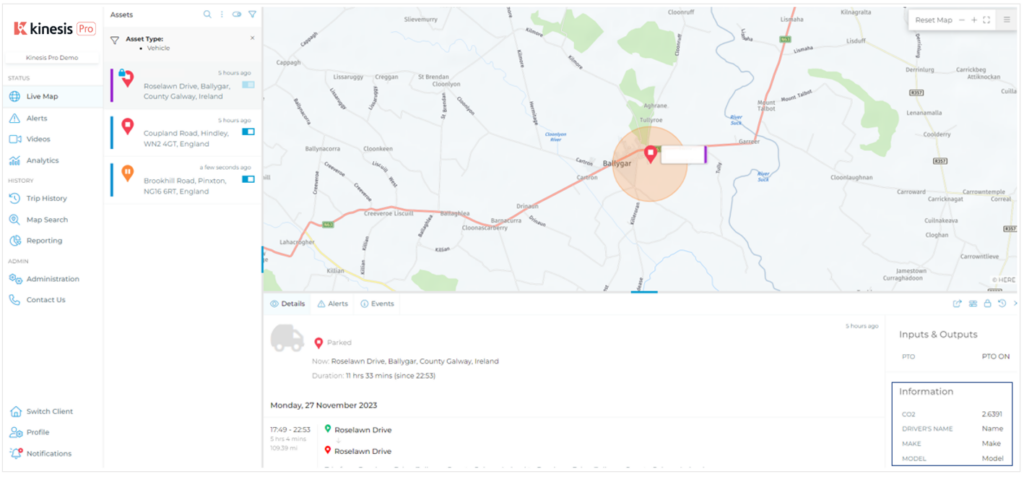
Reporting
Certain reports include the option of including Custom Field information in their layout. Choose the information you would like to add to the report. Below is an example of the Trip Listing Report, and where to find the option:
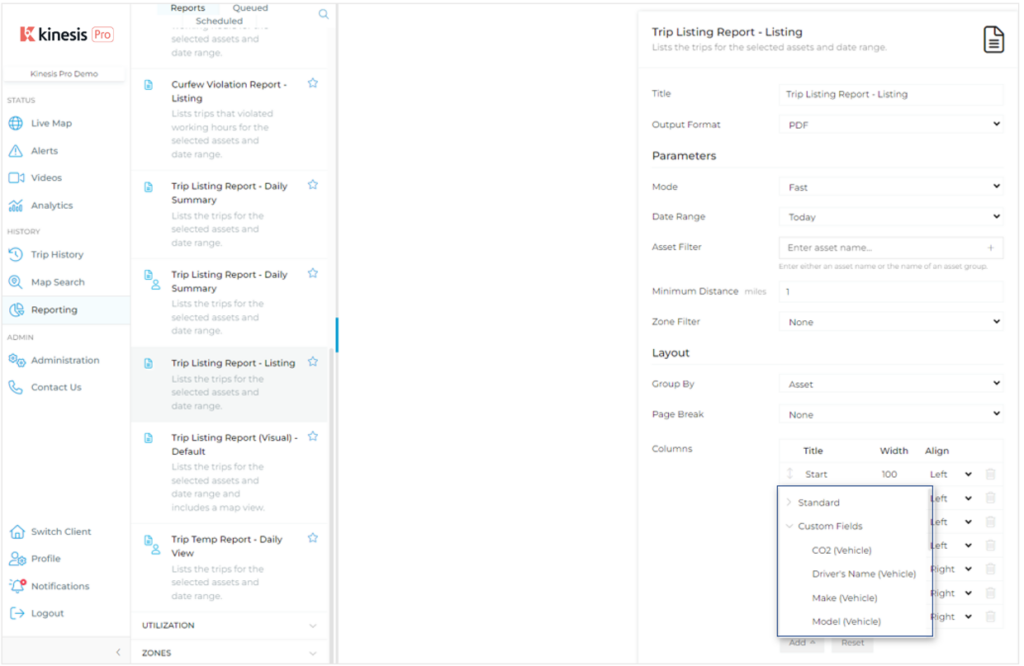
Filtering Items by Custom Fields Information
You can filter items by the Custom Fields headings. This is useful if you have many items, and the same information across multiple items. To filter items by Custom Fields,
1. Go to Administration,
2. Choose the item you would like to search,
3. Click the Filter button,
4. Enter the information in the text box under the heading. The filter will automatically update the items.

5. Organisation
5.1 Cost Centres
5.1.1 Introduction
Cost Centres are designed to restrict access and visibility between different divisions of the same company. Users and Assets can be assigned a Cost Centre, with Users only having access to the Assets assigned to the same Cost Centres.
Cost Centres can be applied to the following items in the platform:
- Users,
- Assets,
- Locations,
- Alerts,
- Reports
As an example,
Client “Example Inc” has branches in two European countries, the United Kingdom and France. They have depots in London, Newcastle, Paris and Marseille.
Each depot in each city manages its own fleet of vehicles and is overseen by the country branch.
The two country branches are managed by managers in the head office.
An organisation chart for the company would look something like this:
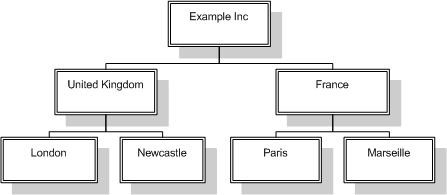
Each block in the diagram is a separate unit within the company that is responsible to the block above it in the tree.
Cost Centre allow for the following restrictions:
- Users in the city divisions can only see, Report on, and create Alerts on their own Assets e.g. a User in the London/Paris depot can only see their Assets.
- Management in the United Kingdom and France branch can only see, Report on, and create Alerts on their depots Assets, but not any of the Assets in the other country branch/depots.
- Top management at Example Inc can see, Report on, and create Alerts on any of the Assets, regardless of country or city.
5.1.2 Creating Cost Centres
Before creating Cost Centres, first decide what the structure should look like, then copy this into the platform. Cost Centres are in a parent-child relationship. There can only be one parent Cost Centre to start with, where a child/children can be added. Those children may then also act as a parent.
As a default, there is one parent Cost Centre in the platform, called Default. This can be renamed, and children created underneath this.
Navigate to Administration,
Choose Cost Centres under the Organisation section.
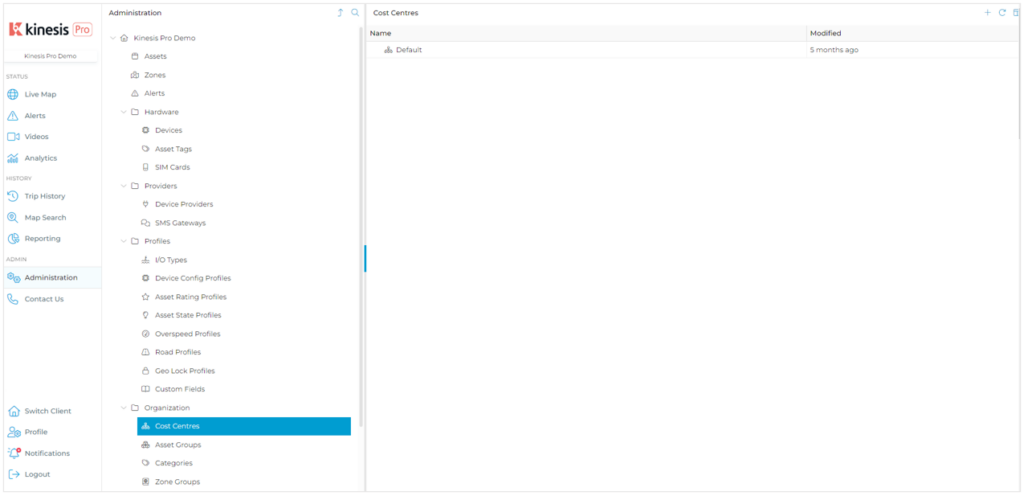
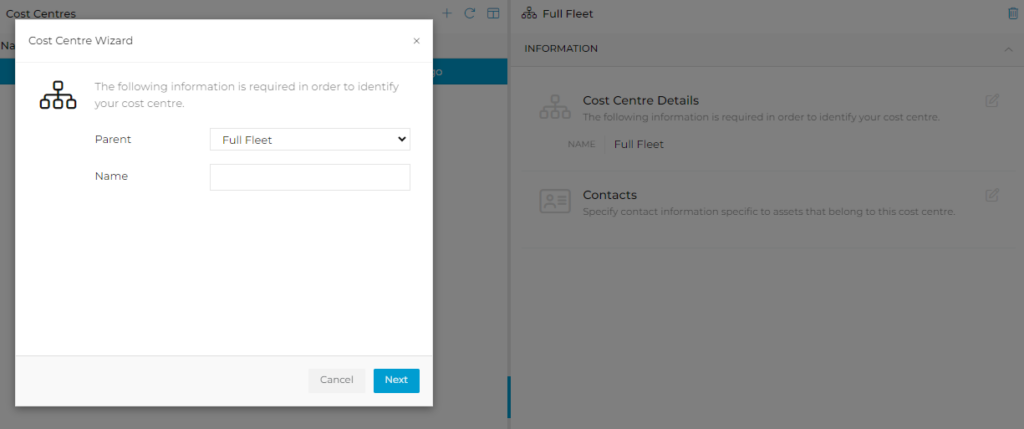
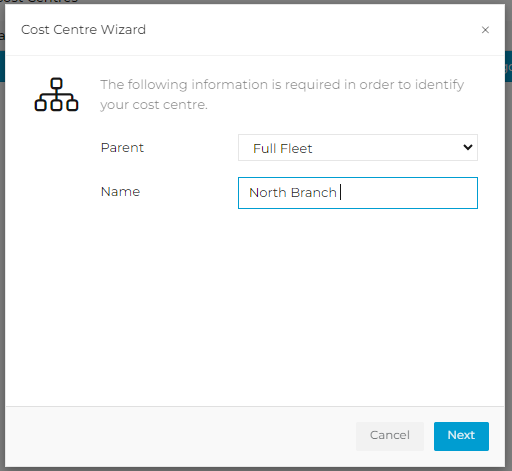
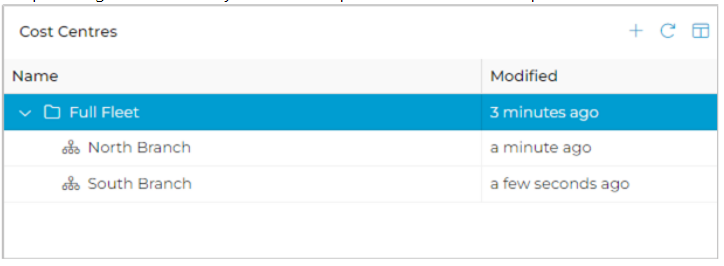
5.1.3 Editing the Information in a Cost Centre
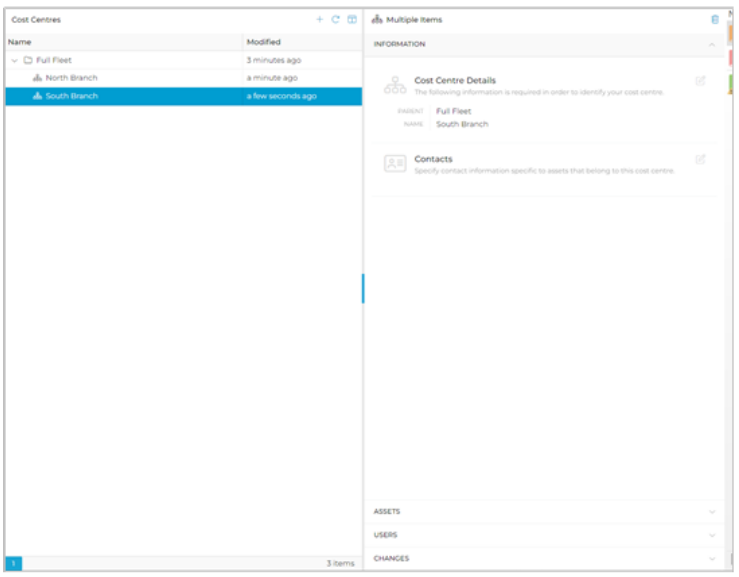

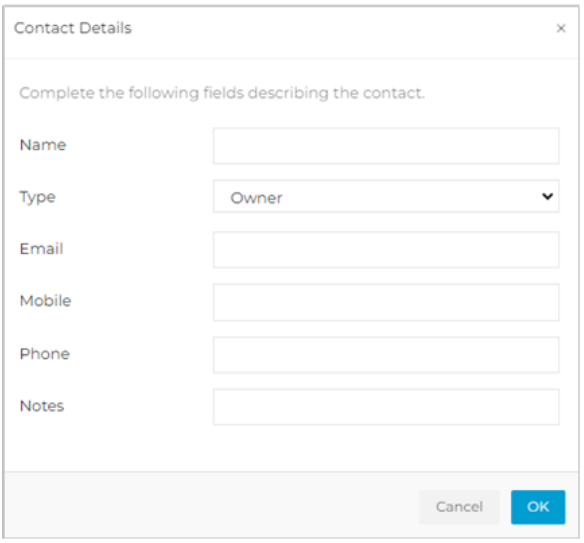
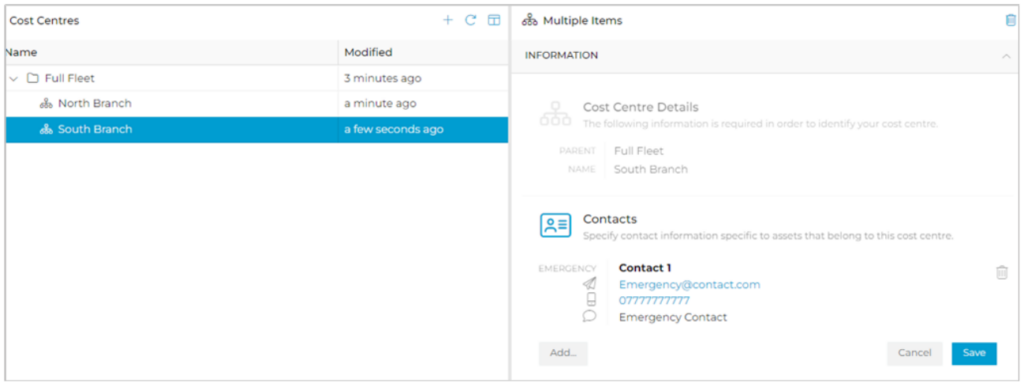
You can see which Assets and Users are assigned to a Cost Centre by choosing that Cost Centre in the list. Choose the relevant section (Assets or Users) to see the information:


5.2 Asset Groups
5.2.1 Introduction
Asset Groups were designed to control and manage Assets of the same type/group.
Assets can be assigned to multiple groups, allowing for comparison of information in groups, and there is no restrictions per User.
A User can see any groups’ Assets. Asset Groups can be applied to the following items in the platform:
- Assets,
- Alerts,
- Reports
5.2.2 Creating Asset Groups
Before creating Asset Groups, first decide what the structure should look like, then create this in the platform. Asset Groups have a parent-child relationship. There can be multiple parent Asset Groups (unlike Cost Centres), where children can be added. Those children may then also act as a parent.
As a default, there is one parent Asset Group in the platform, called Default.
This can be renamed, and children created underneath this.
1. Navigate to Administration,
2. Choose Asset Groups under the Organisation section,
3. Choose the Default Group,
4. Click Edit next to the Asset Group Details.
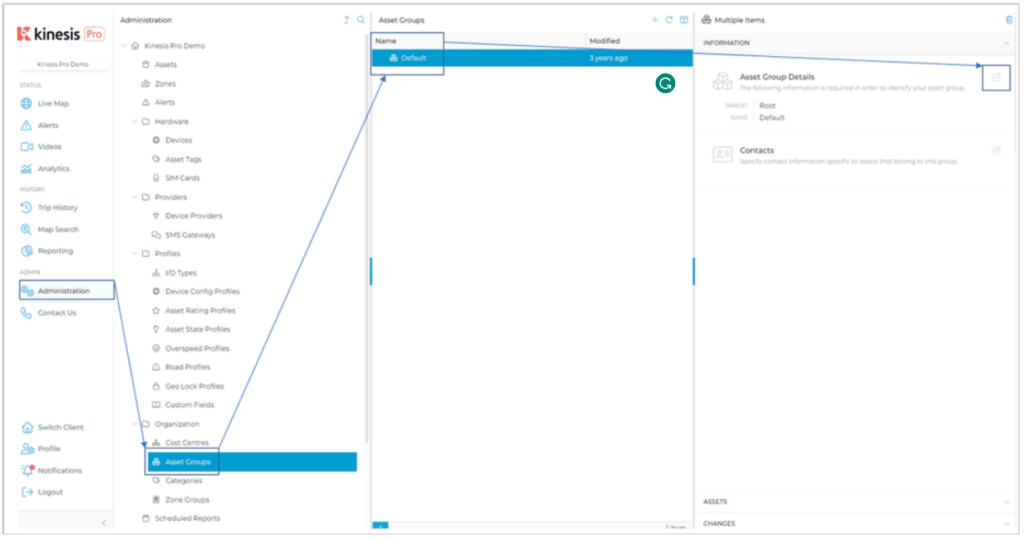
Because there can be more than one parent Asset Group, the highest level is called Root. Therefore rename the Default Asset Group, and keep the Root Parent:
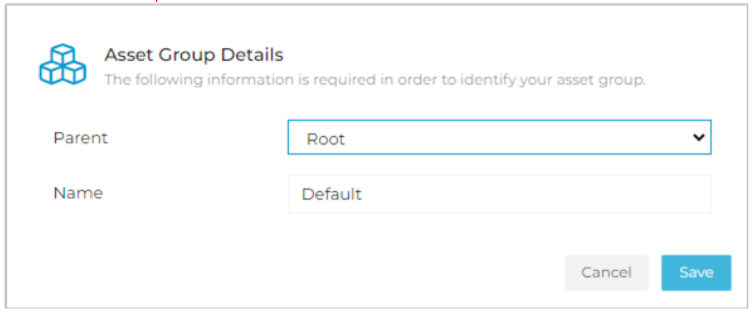

To add a new Asset Group click the Plus button, and create a new Asset Group under the Root, or the renamed parent:
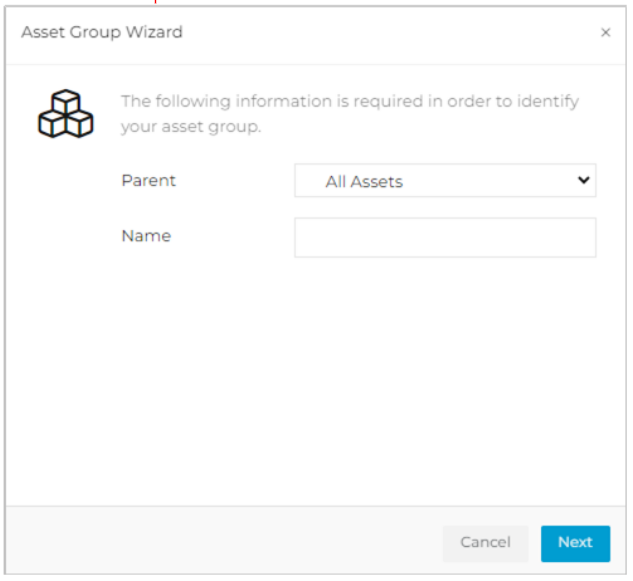
Keep adding Asset Groups until you have completed the structure required.

5.2.3 Viewing Assets in an Asset Group
You can see which Assets are assigned to an Asset Group by choosing that Group in the list. Choose the Assets section to see the information:

5.3 Zone Groups
5.3.1 Introduction
Zone Groups are designed to manage multiple zones, and group these according to business requirements. Zones can be assigned to one group.
Zone Groups can be applied to the following items in the platform:
- Assets,
- Alerts,
- Reports
5.3.2 Adding Zone Groups to an Asset
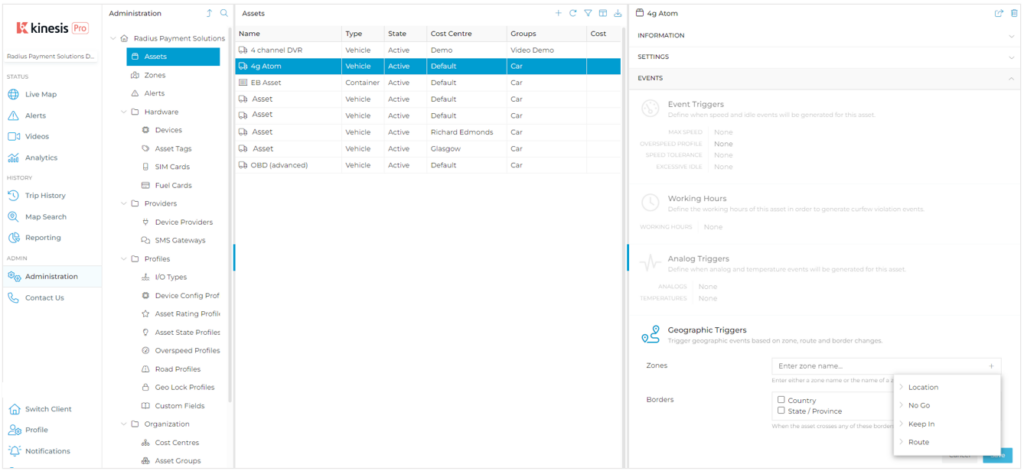
5.3.3 Viewing Zones in a Zone Group
To view which zone is in which Group, navigate to the Zones section in the Client, and the Zones listed will display the Group name:

5.3.4 Creating Zone Groups
Zone Groups are similar to Asset Groups in structure, with a parent-child relationship, and there can be multiple parent Zone Groups, where children can be added. Those children may then also act as a parent.
As a default, there is one parent Zone Group in the platform, called Default Group. This can be renamed, and children created underneath this.
1. Navigate to Administration,
2. Choose Zone Groups under the Organisation section,
3. Choose the Default Group,
4. Click Edit next to the Zone Group Details.
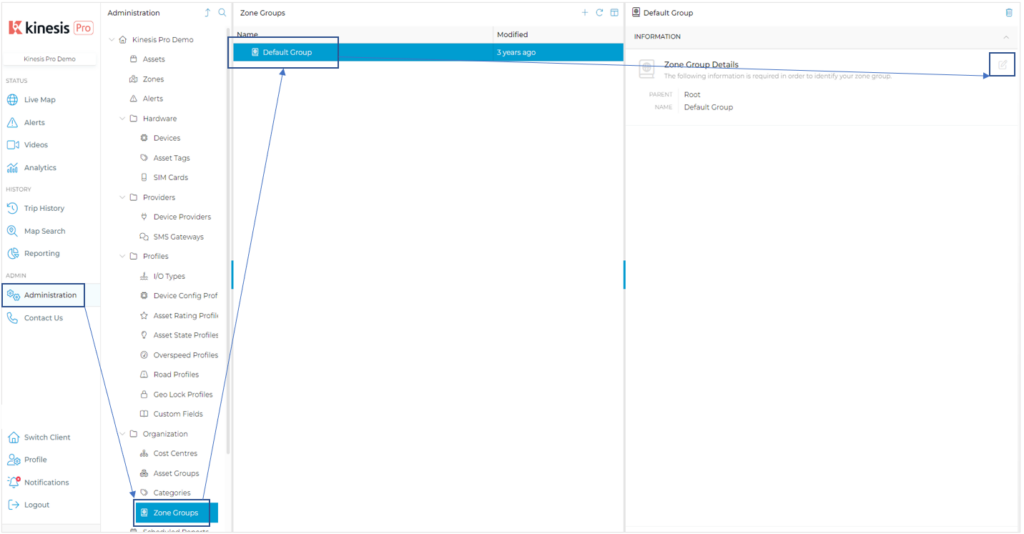
Because there can be more than one parent Zone Group, the highest level is called Root. Therefore rename the Default Group, and keep the Root Parent:
To add a new Zone Group click the Plus button, and create a new Group under the Root, or the renamed parent:
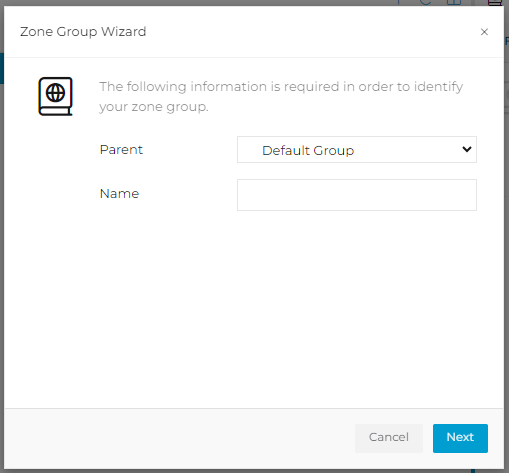
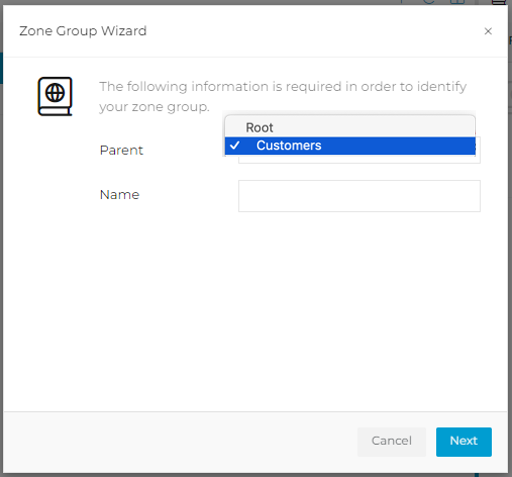
Keep adding Zone Groups until you have completed the structure required.

6. Analytics
6.1 Introduction
The Dashboards section under the Analytics folder of the Administration is used to create and edit Dashboards.
To view a completed Dashboard and the Widget data on it, click the Dashboards link under the Status section.
Clicking the Dashboard section under Administration opens a table of all the current Dashboards in the Client:
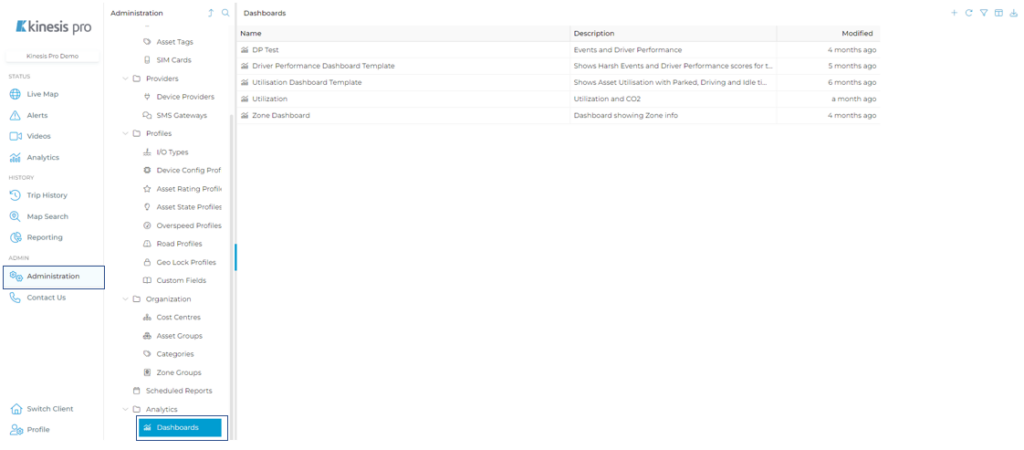
6.2 Creating a New Dashboard
To create a new Dashboard in a Client, follow the steps below:
1. Go to Administration,
2. Choose the Dashboard section under the Analytics folder,
3. Click the Plus button,
4. Enter the information in the Wizard,
5. Click Next, enter the information required on the next screens, until you reach the Finish button.
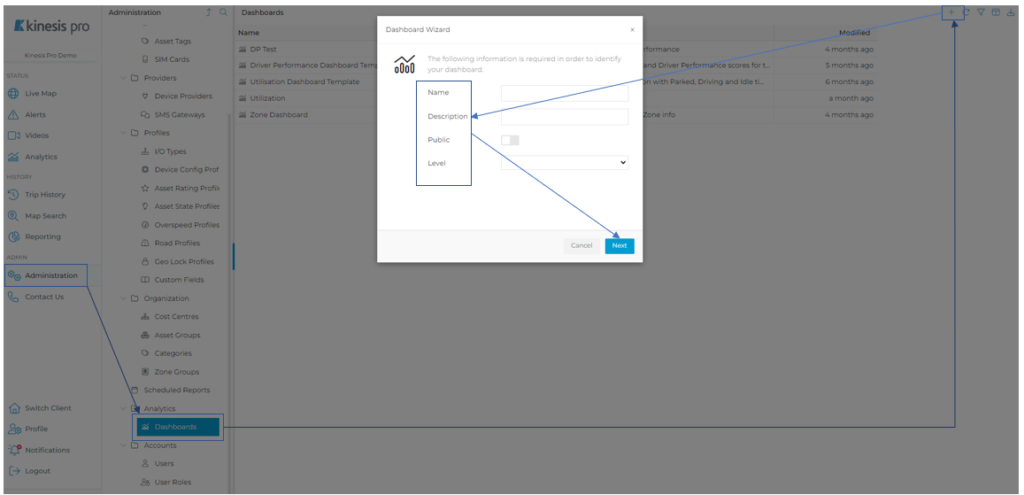
A summary of the information entered will appear on the screen. Make sure it is correct before choosing Finish. Otherwise go Back and edit the information as required.
6.3 Editing a Dashboard
To edit a Dashboard, follow the steps below:
1. Go to Administration,
2. Choose the Dashboard section under the Analytics folder,
3. Choose the Dashboard requiring editing,
4. Enter the Information: Name and Description, and whether Public,
5. Check the audit trail of Changes made.
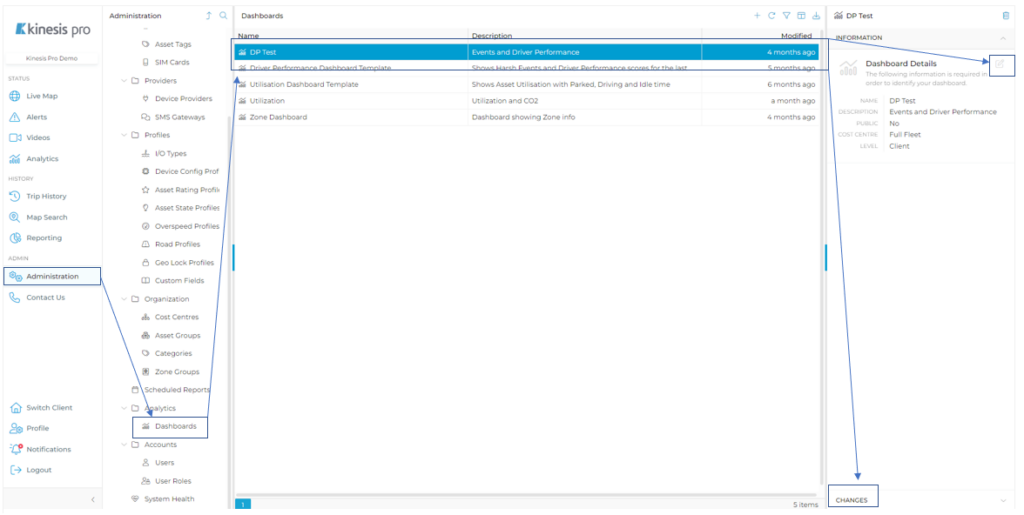
7. Accounts
7.1 Users
7.1.1 Introduction
Users access the platform, and depending on the Features set in the Client, and what roles they have been given, view and manage items on the platform.
The System can create Users in 2 ways
1. Users are invited to the platform, they will receive a link to activate their account, and add their own password. This is the preferred method of adding Users.
2. Users are created by another User, and the password is automatically generated by the platform. The new User either uses the Forgot? option on the Login page to change their password, or the User who created them resets their account to send them a link to change their password.
7.1.2 Create a User
1. Navigate to Administration,
2. Choose Users under the Accounts folder,
3. Click the Plus button,
4. Enter the information in the Wizard.
Important Notes:
1. Leaving the Send Invite checked means the User will receive an email asking them to set up their account.
2. If the User creating the new User unchecks the Send Invite option, the new User will be created, and a password automatically generates. This can be changed by resetting the account or the User using the Forgot? link on the login page.
5. Then click Next.
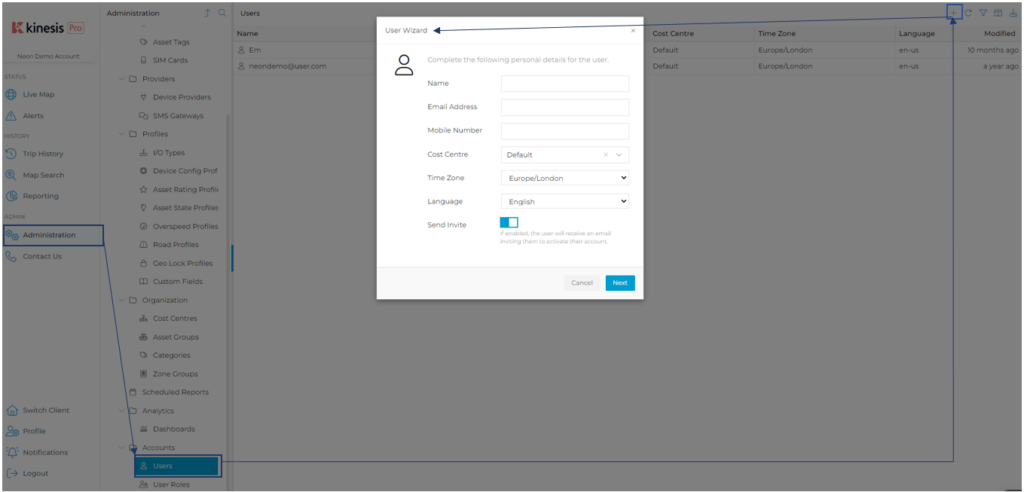
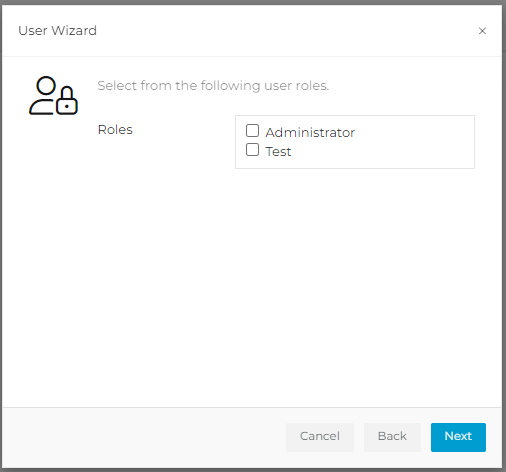
as needed:
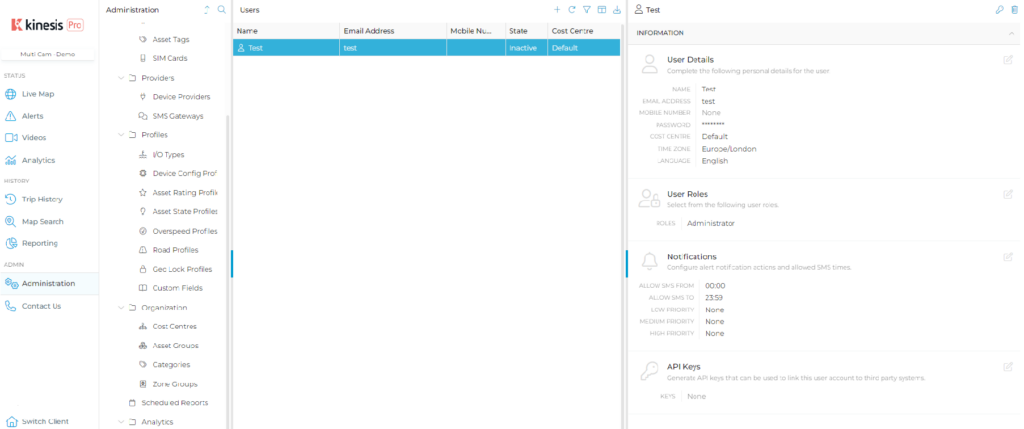
7.1.3 Resetting a User’s Account
If a User has forgotten their password and cannot use the login screen to reset their password, another User can reset their account. This inactivates the User account, and sends them an email with a link to create a new password. This reset option can also be used to reset a password if created automatically by the platform (see above).
1. Choose the Reset button, and
2. Click OK.

7.1.4 Choose How and When Notifications are Delivered
If you would like the User notified when an Alert triggers, please edit the information under Notifications. You can choose to allow notifications for the different priority Alerts, and how and when these are received. Select Email notifications for the Kinesis Pro platform.
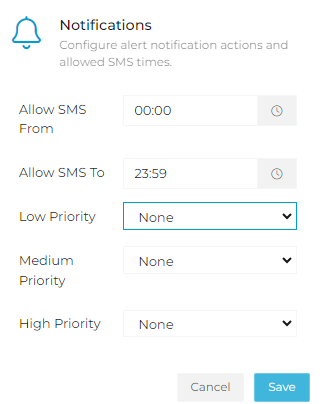
7.2 User Roles
7.2.1 Introduction
Roles were created to allow restricted access to features enabled on the platform.
For example, Roles allow you to let a User view (list) items only, or edit and create them. By default the only Role in the platform is Administrator, which allows a User to view and edit anything they have access to.
7.2.2 Create a role
1. Navigate to Administration,
2. Choose Roles under the Accounts folder,
3. Click the Plus button,
4. Enter the information in the Wizard,
5. Then click Next.
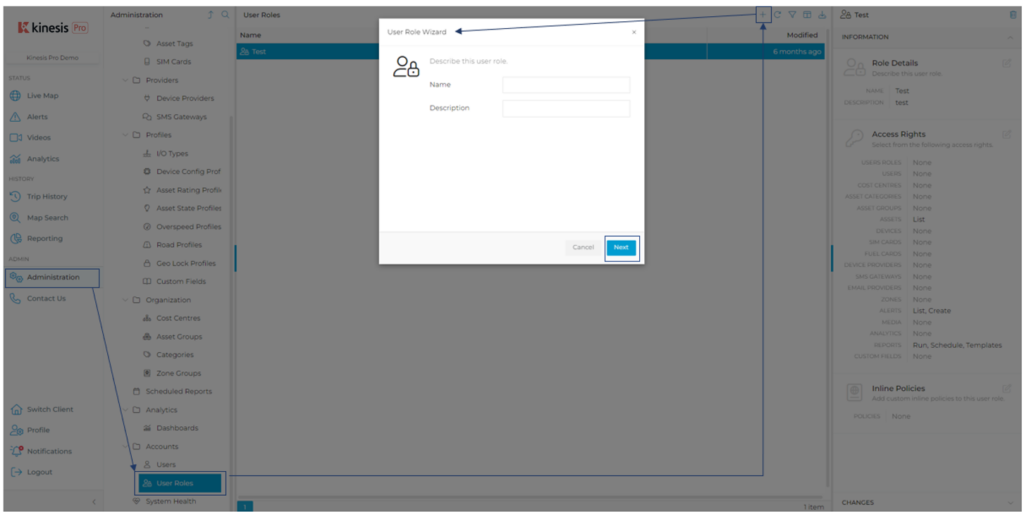
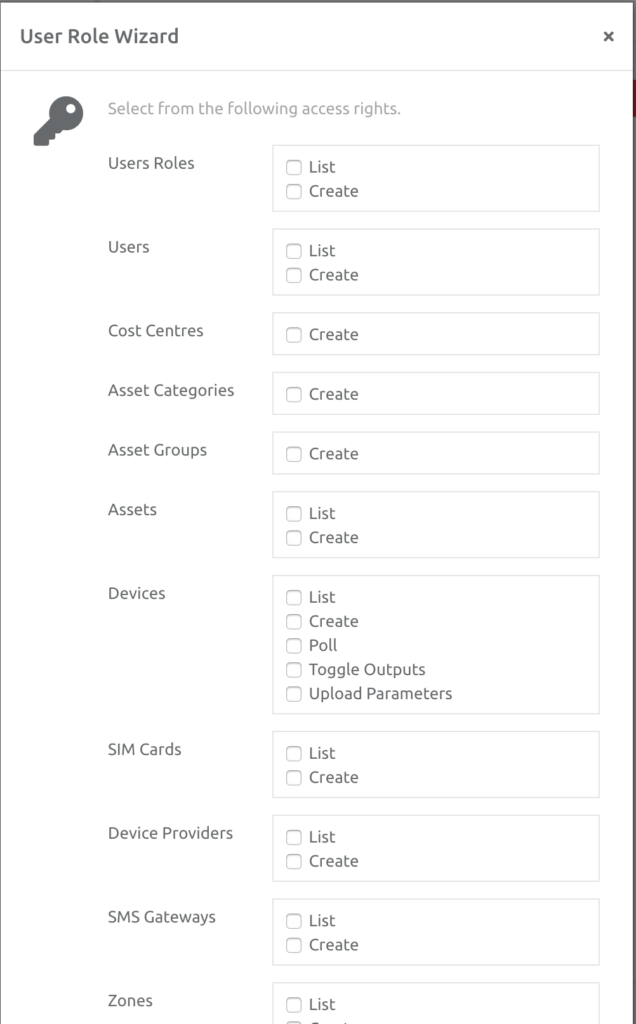
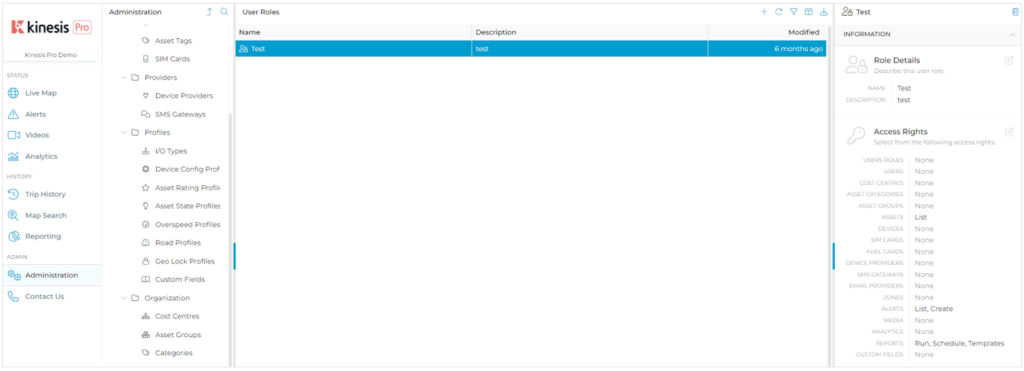
7.2.3 Add a Role to a User
A Role can be added to a user, either when creating the User, or by editing any existing User. This can be done individually, or in bulk.
Keep learning
Need help?
Use our help me choose wizard or contact us on one of the options below.
 United Kingdom - English
United Kingdom - English United States - English
United States - English Ireland - English
Ireland - English Netherlands - Dutch
Netherlands - Dutch France - French
France - French Germany - German
Germany - German Italy - Italian
Italy - Italian Spain - Spanish
Spain - Spanish Belgium - Dutch
Belgium - Dutch Portugal - Portuguese
Portugal - Portuguese Singapore - English
Singapore - English Malaysia - English
Malaysia - English Australia - English
Australia - English New Zealand - English
New Zealand - English